 By Pepper Parr By Pepper Parr
BURLINGTON, ON October 30, 2012 They opened the place 35 years ago – times does fly.
When did that orange piece of metal work outside the building go up? That long ago eh? Maybe I’m actually getting used to it.
 Placed outside the Art Centre in 1978 the aluminum structure has drawn attention to the Centre. The structure is A Space Composition for Rebecca by artist Haydn Llewellyn Davies, who died in 2008. It is orange aluminum and has been a fixture outside the building since 1978.
The Burlington Art Centre Foundation is going to hold a three part auction with thirty five items in each part to highlight and focus public attention on their 35th year of existence.
Applications to be considered for the Art Auction in 2013 close November 23, at 5:00 pm.
 The three parts are 35 Live, 35 Onsite and 35 Online auctions for objects from visual artists working in all medium. Entries for the three auctions will be selected by a jury of experts to ensure quality and an offering of unique and original pieces. The three parts are 35 Live, 35 Onsite and 35 Online auctions for objects from visual artists working in all medium. Entries for the three auctions will be selected by a jury of experts to ensure quality and an offering of unique and original pieces.
Each category will include a range of art forms and values. Category selection will be made, in part, by a determination of which pieces will be best suited to which audience, thereby increasing the opportunities for a successful sale.
Artists must submit a completed Art Auction 2013 Submission Form, along with a digital image of the artwork, by Friday, November 23, 2012, 5:00 p.m.
This call is:
Open to all artists who are residents of Canada
Members of the BACF Art Auction Committee are not eligible
Works submitted must be original works of art or fine craft, created within the past two years
New Media/Digital & Photographic artwork must be signed, limited editions, with a maximum of 10 prints of that image, in any size
Two dimensional artwork must be mounted or framed, wired and ready for hanging Archival quality materials must be used.
Each artist may submit a maximum of two pieces through the Call for Entry process, but no more that one piece from each artist can be accepted for the auction.
For complete details and a submission form please go to www.theBAC.ca/call
Please review the information on the Call For Entry Pamphlet and send a completed Submission Form, along with all required information and a digital image of your artwork, by Friday, November 23, 2012, 5:00 p.m., for consideration by the jury.
We prefer that you use the Art Auction 2013 Submission Form that can be completed and saved in Word. However, if this is not possible, you may print out a form or the pamphlet and complete the information by hand. Please help us by printing legibly.
Label your images with your last name, first initial, 2013, and the title of your piece. (e.g. smithj2013sunrise.jpg)
Email submissions to auction@theBAC.ca (preferred), or deliver, in person or by mail, to:
Burlington Art Centre, Art Auction. 1333 Lakeshore Road, Burlington, ON, L7S 1A9

 By Pepper Parr By Pepper Parr
BURLINGTON, ON October 30th, 2012 More changes on the staffing side at city hall. The search for a third general manager doesn`t appear to be going all that well. Could the city manager do the job with just the two general managers? Can Kim Phillips who handles the corporate and administrative side of things and Scott Stewart doing the heavy lifting on the operational side keep the good ship Burlington on an even keel?
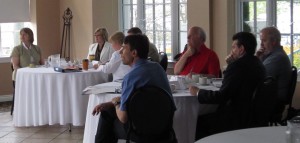 Alan Magi, foreground in blue shirt, listens intently during the development of the Strategic Plan last year. Magi wasn’t able to get people to listen during the recent governance review of that Strategic Plan; partly because he didn’t have much to say. City Manager Jeff Fielding explained to a city council workshop that he was stretched pretty thin on the senior staff side and has a couple of people who aren’t pulling their weight.
Alan Magi certainly didn’t cover himself with glory when he lead council and staff through a governance review and a closer look at the strategic plan now that we are well into our first year with that document.
While Kyle Benham isn’t a city “employee” he too is getting a stern second look by both his board and city council. There are those who think that board is far too large to be effective and many wonder if it can do an effective performance review of their Executive Director.
The mess with the IKEA plans to move from their Aldershot location on Plains Road to a site on the North Service Road just west of Walkers Line threatens the efforts on the part of the city to retain IKEA as a corporate client.
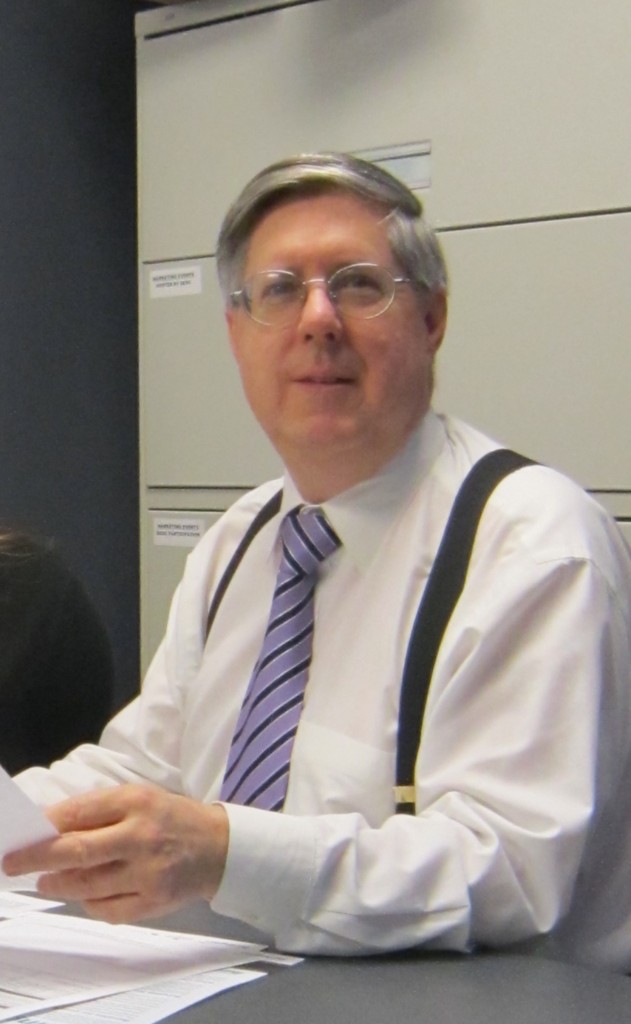 Kyle Benham, Executive Director, Burlington Economic Development Corporation – will he make it past the performance review? The Economic Development Corporation hasn’t been bringing forward very much in the way of new business to the city. Other than running full page advertisements in the business press telling the commercial world that we are the second best place to live in the country there isn’t much to see for what is being spent on that department. Those who are betting people won’t even need odds to get a return on their money if they bet on major changes over at the Burlington Economic Development Corporation.
There are some really smart people at city hall who think the whole thing should be blown up and re-created as a much smaller board; say seven members rather than the 20 people who populate that board now.
Economic development is far too important a matter to play around with. The Molinaro project next to the GO station is going to result in 1000 housing units; the ADI project on Guelph Line is going to result in 70+ units; the project being worked up for Ghent Street is looking for more than 50 units. Many of the people that move into that housing might want to work in Burlington – but there have to be jobs for them. The city also needs the tax revenue from the ICI (Industrial, Corporate, Institutional) portion of the property base.
Tax revenue from ICI for 2012 looks like it will be less than it was during 2011 – not a good sign and one that is giving the city manager and the treasurer heart burn.
Frank McKeown advised the mayor a few months ago that he wanted to move on from his role as Chief of Staff. Many wonder if Rick Goldring is ready to fly on his own and if Jackie Isada, who is moving from the sinking ship over at economic development and into the Mayor’s office, will be able to fully replace
McKeown. Many think that is a stretch.
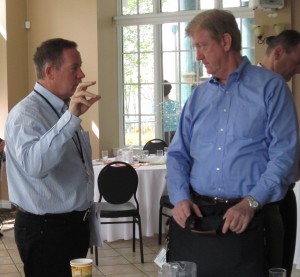 Frank McKeown, on the left talks with Ward 5 Councillor Paul Sharman during the Strategic Plan sessions. McKeough leaves the Mayor’s office at the end of the year – is there a future for him elsewhere at city hall? Many hope so – the talent is needed. Frank on the other hand still talks about a political role in his future and is on record as saying that if there were a seat open he might go for it. The rumour is that he kind of likes the look of Ward 4 – is Jack Dennison ready to throw the towel in over there?
McKeown doesn’t have to work but his administrative and analytical skills are both in demand and badly needed at city hall. Expect to see him staying on after he finishes the transition out of the Mayor’s office and in some senior role where he would work very closely with the city manager.
City Manager Jeff Fielding is doing everything he can to upgrade the skill sets and the competencies of his staff and will have everyone from Supervisor level up taking courses created for the city by people at the DeGroote campus of Master University on the South Service Road.

 By Pepper Parr By Pepper Parr
BURLINGTON, ON October 29, 2012 They are doing this for the 10th time – the Art in Action, an artist’s collective that organizes studio tours in the city with up to ten homes opened to the public where the work of various artists is on display.
Along with showing the work of the artists in the city, Art in Action sponsors scholarships and are generally promoting the health of artists.
Each year new artists are added to the list of about 35 people who show their work. Among those being added to the list this year are Kyle Brook, Donna Grandin and Monica Bell.
For Donna Grandin “making art brings beauty and pleasure into our everyday lives”.
 The richness, almost exotic colour we see in the Caribbean is reflected in Grandin’s art. Her artistic inspiration comes from living plants interacting with their environment, sun shining through the leaves, wind blowing the petals, other plants in the background adding variety and contrast. “I try to express the atmosphere, the memory of a specific moment in time, and my feelings about the place. In my current series of acrylic paintings, I focus on tropical flowers, foliage and fruit, drawing on my experience growing up on a lush Caribbean island”.
While her art is “representational” Grandin sets out to “communicate the abstract rhythms of nature,”. “I play with the organic shapes and vibrant colours to create uplifting and engaging images” and that she does.
Donna Grandin is a Caribbean artist, born Donna Gomez in St. Lucia in 1974. At the age of 17, Donna went to school in Canada, and in 1997 she graduated with an Honours B.A. in Art from McMaster University. She has been represented by galleries in St. Lucia for a number of years, while living and travelling in Europe with her husband before returning to live and paint in Burlington, Ontario.
 Red seldom gets as luscious as this. Donna’s paintings have been in both solo and group exhibitions in Ontario and St. Lucia, and are in private collections in Canada, the U.S., and the Caribbean. Honours include the gold award in visual arts in the M&C Fine Arts Awards competition in St. Lucia in 2001, and a mural commission by the City of Toronto in 2009. Donna exhibited at Toronto Art Expo in 2011. This is her first participation in the Art in Action Studio Tour. She is exhibiting at Sparling Cr., in the east end of the city.
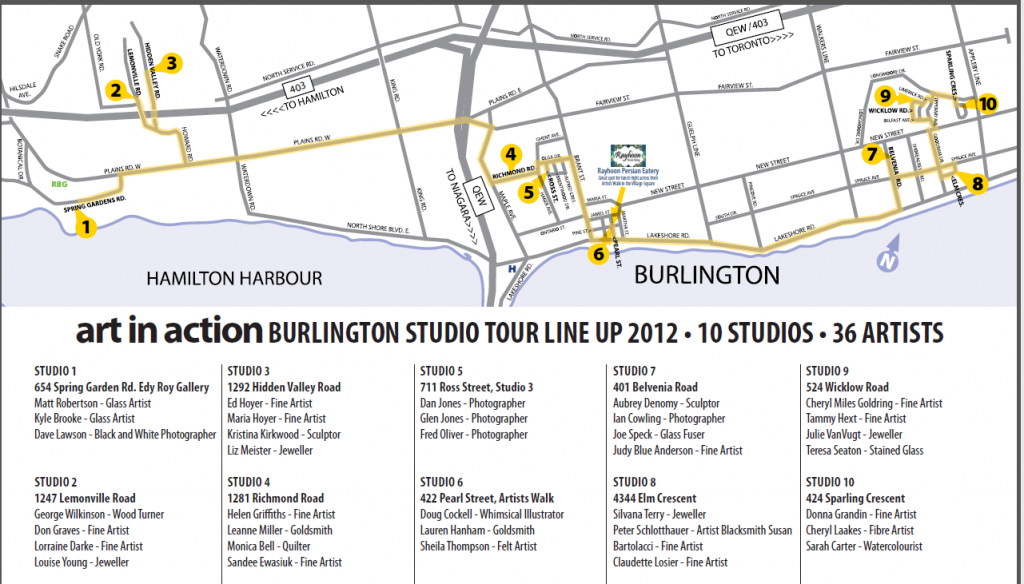
The Art in Action Studio tour takes place on Saturday November 3rd and on Sunday the 4th. The location of the ten studios is shown on the map below. Hours are: 10:00 am to 5:00 pm. You can do the full tour in a day and have time for a leisurely lunch as well.
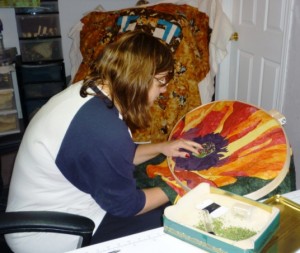 Monica Bell working on a piece of fabric. One of 36 artists on the Art in Action Studio Tour. New this year to the Art in Action Studio Tour is fabric artist Monica Bell who took her first quilting class when working as a recreation therapist for a retirement and long term care facility. The first quilt she made was an Irish Chain which was raffled off during a fund raiser for the recreation department. The second quilt didn’t come for some time and that was followed by an invitation to a quilting retreat by a cousin. “ I have never laughed and learned so much as I did that first retreat,” said Monica – she was hooked and since 2008 quilting has become an obsession for her. “I easily lose track of time and become engrossed in my project as it relaxes me and energizes me at the same time. My work started with traditional patchwork techniques and through the years I have started leaning toward the more contemporary designs.”
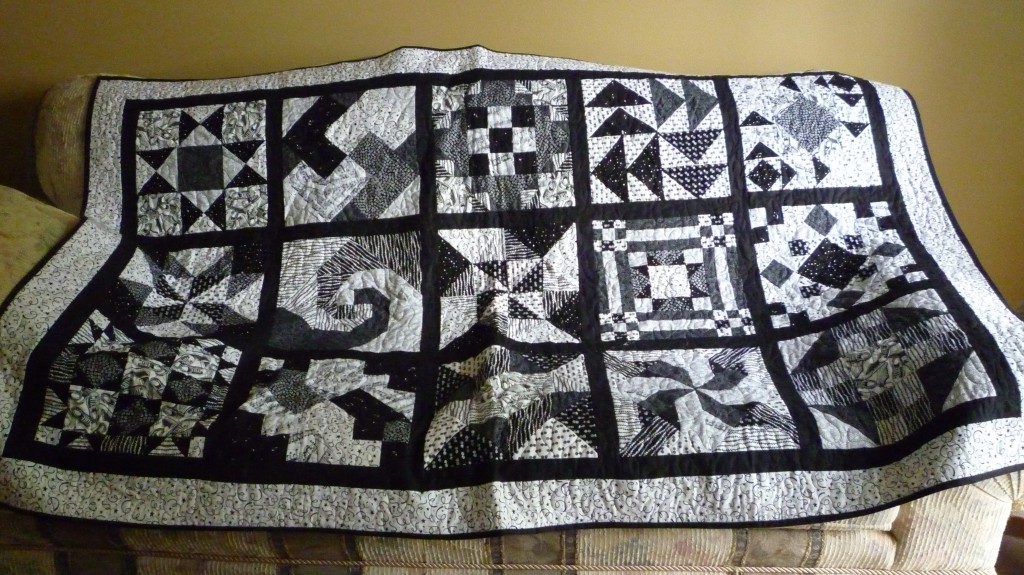 This quilt is quite a bit jazzier than the traditional Mennonite quilt – but then this quilter isn’t a Mennonite. “Daring to be Bold is my first original design. I love to work with printed cottons and Batiks but have started to experiment with the use of other textiles. I use many techniques including hand embroidery, hand and machine appliqué, beading, use of wool fibers, and machine quilting using both my domestic sewing machine and a long arm quilting machine.” Clearly a growing fabric artist – you will enjoy her work.
The Studio Tour is new for Kyle Brooke who grew up in the Mile High City of Denver, Colorado at the foothills of the majestic Rocky Mountains. Raised by a family of fine artists, craftspeople and musicians, Kyle’s childhood was filled with gallery visits, art fairs and a deep appreciation and passion for the arts. As a result, Kyle has always striven to learn new techniques and has developed an exceptionally broad background in the arts and crafts.
 The translucence of these two pieces almost lifts them off the table. Kyle spent two years studying graphic design and then began experimenting with various art forms, from water-color paintings and photography to ceramics and jewellery making. From an early age, Kyle has been intrigued by the medium and art form of glass and made the decision to travel to Canada to focus her undergraduate college education on glass art.
When Kyle arrived at Sheridan College, she began her education in the Art Fundamentals program to develop a solid skill base. After successfully completing the course, she entered into the Sheridan College Crafts and Design Glass Studio.
 Almost as if the earth has opened up. Kyle Brooke has certainly lifted this art to a new level. Upon graduation Kyle spent over a year traveling across Canada and the United States attending various art conferences and exhibits. She settled in Oregon and worked for the Bullseye Glass Company and the Eugene Glass School. This experience helped to enhance her knowledge, contacts and techniques. As well as keeping her current on important industry trends, events, artists and opportunities.
In early 2009 Kyle took that experience and resettled in Canada where she became a part of a movement in contemporary art. Kyle continues her journey creating, teaching and promoting glass art in her community. She has honed her skills as a professional well-rounded glass artist while energetically promoting glass as a contemporary art form
In the past 3 years, Kyle has been a resident artist at the Living Arts Centre on Ontario Canada and continues her education by attending courses and conferences all across North America. Her work ranges from bold sand castings and blown forms to elegant jewellery. She is an ambitious self-motivated individual who is passionate and dedicated to furthering her growth and development as a glass artist.
In 2011 Kyle Brooke and her partner Matt Robertson opened their own studio/gallery, The Edy Roy Glass Gallery in Burlington, Ontario, where she creates, teaches and showcases both functional and non-functional glass art.

 By Pepper Parr By Pepper Parr
BURLINGTON, ON October 21, 2012 Burlington could begin to see commemorative plaques all over the place.
Heritage Burlington, the city’s advisory committee on heritage matters, has had a request that it look into a plaque to recognize the people who originally owned the property that is now Sherwood Park.
Rick Wilson, a member of the Heritage Advisory committee has been wanting a plaque in Burlington that tells the story about the Burlington Races, a name used to tell part of the War of 1812 story. Wilson believes there is ample evidence to show that events took place right off the shores of this city in 1813 that were pivotal to the outcome of the War of 1812.
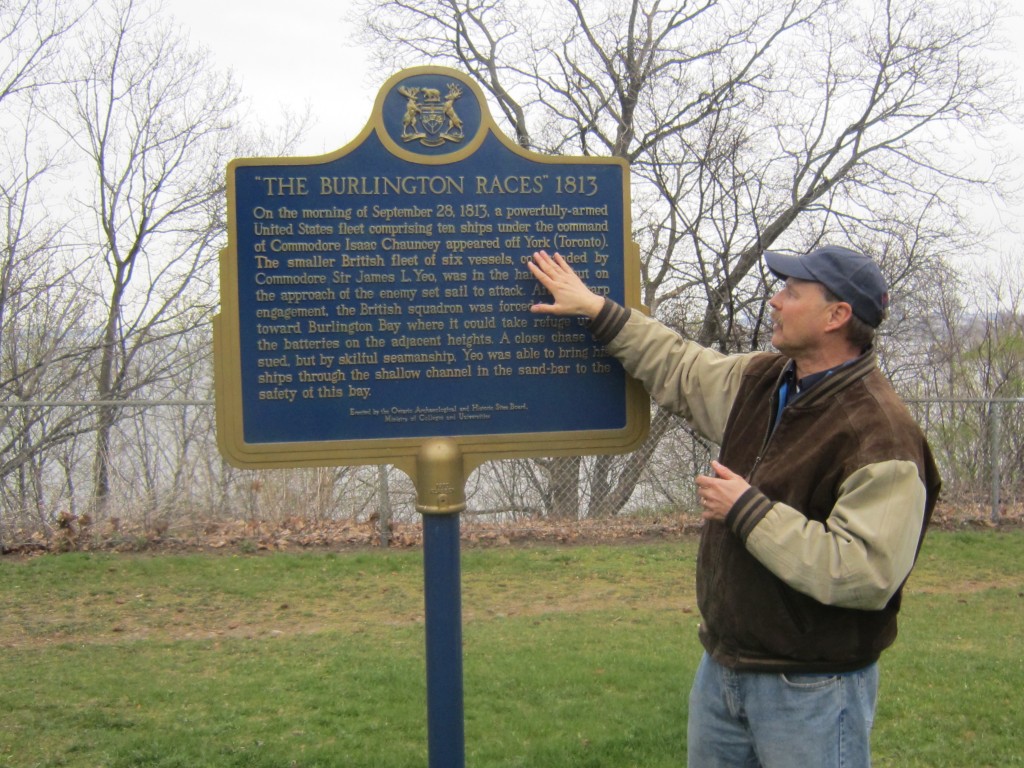 Rick Wilson, a member of the Heritage Burlington Advisory Committee, points out what he believes is a glaring error on a historical plaque, located in Hamilton overlooking Burlington Bay. Wilson hopes there can eventually be a plaque in Burlington correcting the error. There is a plaque over in Hamilton that Wilson claims is just completely wrong but he hasn’t been able to get that plaque changed. Those plaques we see in parks and other public places are put up by both the federal and provincial governments. The one that Wilson claims is wrong was put up by the province. Wilson claims Jane McKenna, Burlington’s MPP is just “blowing me away” and that Mike Wallace, our MP has tried to get something done but the sign is a provincial jurisdiction and there is nothing he could do. Wallace was able to get Wilson into the Fort York event in Toronto last summer at which the Prince of Wales was the feature attraction. Wilson is eternally grateful; that’s another Wallace forever vote.
Councillor Meed Ward suggested to the advisory committee that they pull together all the documentation they have and send it to the appropriate people within the provincial government; “if you make your case clearly enough you will be heard” was Meed Ward’s advice. Heritage Burlington just might take this one on. Turns out Jim Clemens, chair of the Advisory Committee has a strong contact within the arm of the provincial government that over sees the erection of those plaques all over the province.
Burlington has a very strong waterfront history but we aren’t particularly good at telling our story. That might be part of the difficulty behind all the problems we have with wanting to highlight our local history. One is very hard pressed to find any reference to the canning factory that was once the biggest commercial operation in the city. It was located on the property that now houses the Waterfront Hotel.
We have a Historical Society that does a good job of collecting data on our history; but we don’t do a very good job of getting those stories out of the archives and in front of today’s public.
The city does have a system for listing any property that has even a hint of historical significance and that really upsets many people. A property along Lakeshore Road owned by the Morrison’s was said to have historical significance, which the Morrison’s claim is totally bogus, and they want their house taken off any list the city has.
There are lists, some of them are of little use, but there are other lists that are vital if Burlington is to have any hope of maintaining some of the historical properties.
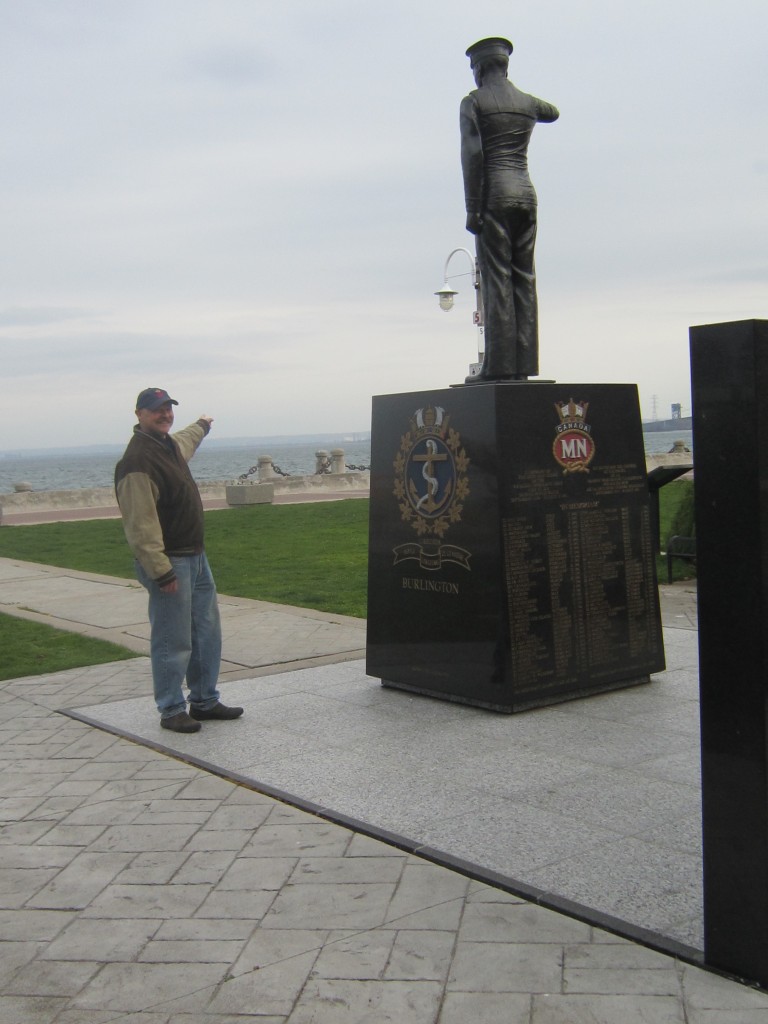 The Navy Memorial on the Waterfront is close to the best piece of historical recognition in the city. It is a truly remarkable statue that pays tribute to the merchant marine and naval activity in WW II. This memorial was created by community groups and put up in a city that really doesn’t have a marine or naval tradition. It does however go to show that there is a deep interest in telling our story. Wilson is pointing to a part of Burlington Bay where he believes the Burlington Races probably took place. One of the problems is that in this city the real estate community has convinced the public that any kind of a historical reference to a piece of property lessens the value of the property. In other cities a historical reference adds significant value to a property. There is still a lot of educating to be done in this city. While there is some leadership on this at city council there is none from the real estate community. Their bread and butter comes from the sale of homes – and homes with a demonstrable historical significance are more valuable in many cities – look at Niagara-on-the-Lake if you want an example.
This designating of property for historical purposes has been a very contentious issue in Burlington for some time. It has torn different communities apart and created much ill will between otherwise very decent people.
The Advisory committee has been given the task of changing the approach taken to how we recognize what is and what isn’t historical – it is not going to be an easy task.

 By Pepper Parr By Pepper Parr
BURLINGTON, ON October 3, 2012 A robust crowd gathered early in the morning at the First Credit Union branch to be taken through some “vital signs” about our city – it was not a pretty picture.
The research report, launched by the Burlington Community Foundation, measures the city across ten areas of focus, including health and wellness, environment, youth, and newcomers.
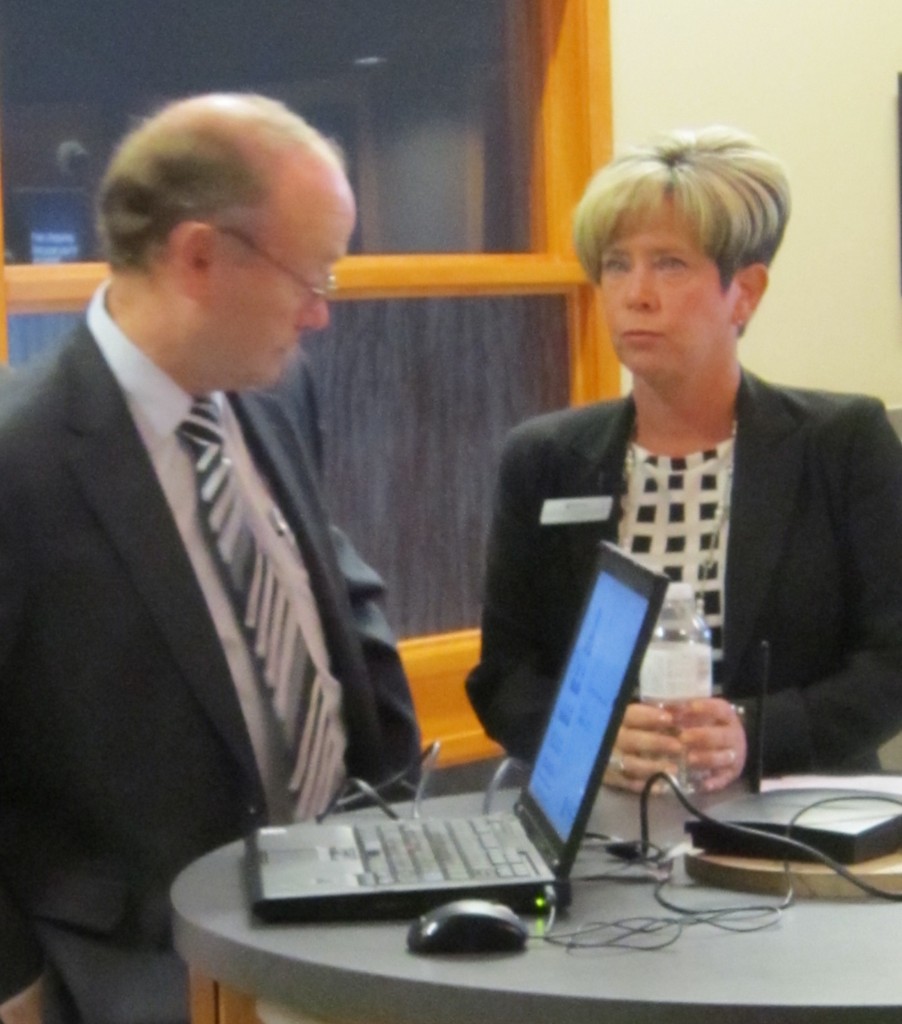 Burlington Community Foundation Tim Dobbie confers with Executive Director Colleen Mulholland about the research report with some stunning data that was made public on Tuesday. “As a public foundation created by and for the people of Burlington, we help people, corporations and agencies accomplish their charitable goals and address our city’s most pressing needs,” said Colleen Mulholland, Executive Director of Burlington Community Foundation. “To accomplish our mission, we first need to deeply understand the community: our strengths as well as areas of need. This is why we have created our first-ever Vital Signs report, a community check-up that evaluates Burlington as a place to live, work, learn and grow by identifying trends that are critical to our quality of life.”
Burlington is a prosperous and affluent community where its individual, household and family median income is 20% higher than Ontario as a whole. This means it is sometimes harder to see the gaps that exist between rich and poor and the rise in mental health issues among youth. .
We are growing, but not at the rate we have grown in the past and in a direction that brings a lot of problems with it. More than 80,000 of the 174,000 people in Burlington are over 45 years of age and 1 in 5 of us come from some other country.
 To fully appreciate just how wealthy we are as a city – look at that field in the middle of the stadium. Burlington’s parks equal 3,303 of those football fields. Burlington has 1463 hectares of parkland – which is the equivalent of 3,303 football fields. That is a lot of parkland.
In a telephone survey to 300 people done by an outside research firm, more than 91% of the people called in Burlington said they donate money to others who are less fortunate.
More than 33% of the people in Burlington volunteer some of their time to helping others make the city a better, nicer place to live.
That’s the plus side – we are, on paper at least, a caring, giving community.
More than 42% of the people in Burlington earn more than $100,000 a year.
The value of the average home in Burlington is $466,000.
We are a rich community as well but we aren’t all rich.
The bad news is very painful. The vacancy rate for apartments is 1.3% which means the market is very tight and that drives up prices. Nice for the landlords but very, very hard for those living below the poverty line – and Burlington has a lot of people living below that poverty line.
The researchers tell us that within a decade we will see 24% of the population living below the poverty line.
Day care in Burlington costs $60 a day. It isn’t possible for low income people to afford day care at that price,which means they don’t work and require social assistance.
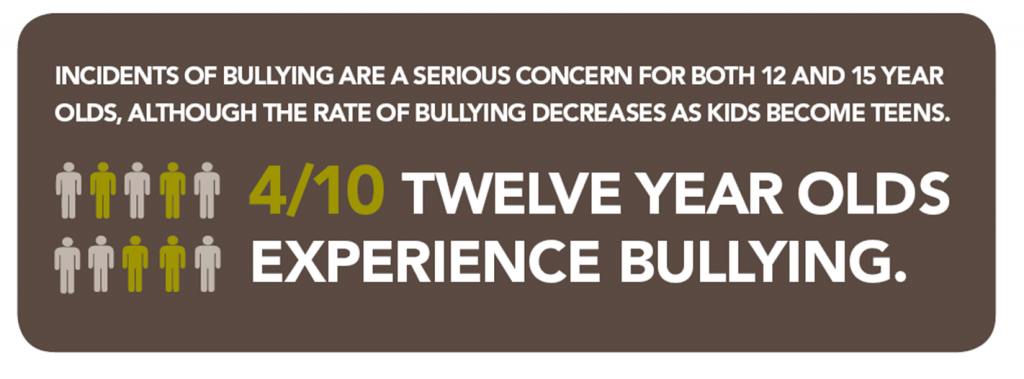 We know who does the bullying and we know for the most part where it is being done. Why aren’t we able to bring an almost immediate halt to this kind of behavior. Is the problem with the children who do the bullying or with the parents of those children. That wasn’t a polite question. 31% of newcomers live in poverty – given that 1 in 5 of us were not born here – that is not a nice number.
24% of the minorities live in poverty.
24% of those who are unattached – a polite word for single mothers, live in poverty. That poverty just grinds these women down and their children suffer.
63% of the people using food banks have been doing so for more than three years. Many thought food banks were a top gap measure. For far too many their trip to the food bank is your trip to the supermarket.
 This is what poverty looks like – bleak, cold, few prospects and little hope. What does poverty look like? Living on $20,778 a year with one in three living in extreme poverty – getting buy on less than $10,389 a year.
In her remarks Colleen Mulholland told of a woman who said she has to steal to care for her family. Why is this happening?
31% of newcomers in Burlington live under the poverty line and tend to earn 50 cents for every dollar other people earn.
Our social problems are not limited to the newcomers. Our youth are suffering from problems they see as staggering. Four out of every 12 young people between the ages of 12 and 15 experience bullying. We know who is doing the bullying – why have we not managed to have it stopped?
Between 10% and 15% of the teenagers have thought of harming themselves.
Between 19% and 27% of teenagers feel they have too many problems.
Between 6% and 11% of teens have thought of committing suicide.
This is a part of the rosy picture we paint of the city we call the nicest place to live in Canada.
When the data was delivered to a room of more than 60 people, BCF chair Tim Dobbie, with a dazed look on his face said “Wow”! It was not a happy wow. He followed that up with a “so what do we do now?”
And indeed that is the question – what do we do now?
Why do we have these problems? Is it all the result in an unequal distribution of the wealth we have? Is it because parents are too busy to do their job of raising their children? Are the schools failing us? Is this happening because we are no longer much of a faith based society?
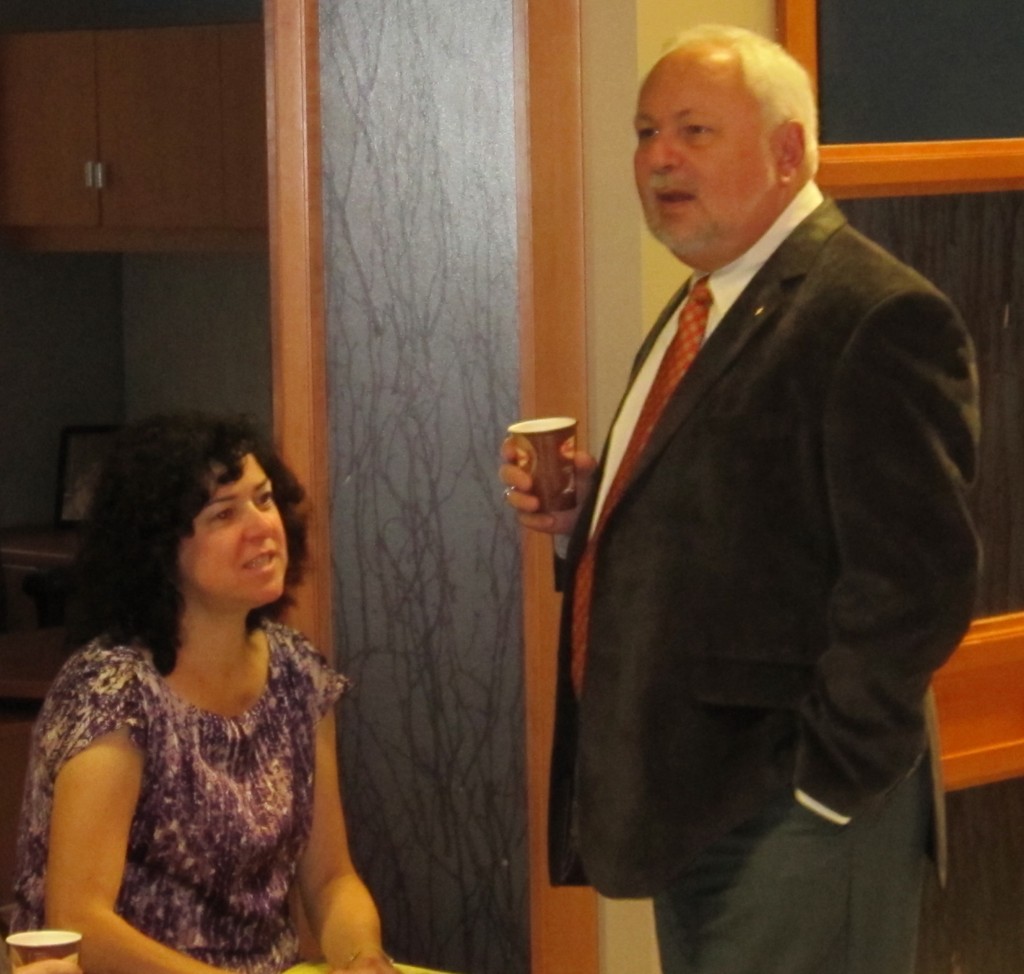 Len Lifchus, CEO of the Burlington/Hamilton United Way, the organization that raises funds which are delivered to agencies that deliver support services, listens to data he is all too familiar with. These aren’t polite questions – but when a parent is called to the hospital to talk to the emergency staff about their child having harmed themselves or worse, and this is happening now; when the police knock at your door to tell you that your child has committed suicide, being polite just doesn’t matter anymore.
This report comes out as we get into the 2012 United Way campaign where we need to raise $2.1 million to take care of those who live under that $20,778 poverty line and especially for those that have to try and get by on $10,389.
Do we see the link between the drug use and the social problems? Our Burlington covers the police stories and note that the police are kept very busy tracking down the drug dealers. Having been offered a “joint” as I was coming out of the library a number of months ago I can attest to the size of the problem – the kid was less than 20, taking a break and inhaling that funny smelling cigarette. We all recognize the smell – do we recognize the problem?
It was a tough report that we had to hear and the BCF people deserve full credit for seeing the need and the courage to put the facts before us. Hopefully we will have the courage and the concern to do something about those facts.
Vital Signs is a community check-up conducted by community foundations across Canada that measures the vitality of our communities and identifies significant trends in a range of areas critical to quality of life. The check up is coordinated nationally by Community Foundations of Canada.
The Burlington Community Foundation was established in 1999 by a passionate group of local volunteers and philanthropists to improve the quality of life in Burlington. Several of the city’s former Mayors were instrumental in getting the organization off the ground.
The initial funding came from a Mayor’s Gala sponsored by Rob MacIsaac; the first meeting of the Foundation was chaired by former Mayor Walter Mulkewich.
The Foundation helps people create funds and support meaningful local causes. The Foundation’s experts understand the community and help donors respond to vital needs by providing grants to charities.
The Masquerade Ball, the Foundation’s annual fund raising event tries to sell 600 tickets to the event. They have a lot of fun and the expensive tickets raise the money for the Foundation to operate.

 By Pepper Parr By Pepper Parr
BURLINGTON, ON September 28, 2012 Every Mayor decides at some point, what kind of a mark they want to make on the city they are leading. That mark is a combination of their hopes and dreams for the city; their background and experience and then the people they know who can help them fashion the mark they are going to leave.
That’s the dream – and it bumps into the cold hard reality of the world of politics and people and the economy they have to deal with.
There is a load of frustration and disappointment in being a Mayor and while many think the Mayor is “popular” and can call anyone for help – the truth is – it is very, very lonely at the top.
 Saturday evening the Mayor’s Cabaret will be held at the Burlington Performing Arts Centre. Getting the production to the stage was a bumpy road. A delay with the show date and a tremendous amount of work by the Mayor’s staff hasn’t produced the results they wanted. These events have to be carefully worked through to determine who the audience is supposed to be and then figuring out how you get them into the building. Saturday evening the Mayor’s Cabaret will be held at the Burlington Performing Arts Centre. Getting the production to the stage was a bumpy road. A delay with the show date and a tremendous amount of work by the Mayor’s staff hasn’t produced the results they wanted. These events have to be carefully worked through to determine who the audience is supposed to be and then figuring out how you get them into the building.
It isn’t going to be a sold out event – and there probably won’t be a second Cabaret.
Burlington doesn’t have a long tradition of Gala’s headed up by the Mayor. This type of event became popular in the 90’s with former Mayor Rob MacIsaac holding the first event and using it to raise funds for the Community Development Foundation.
 Former Mayor Jackson ran a different kind of Gala and then ran afoul of the city manager and didn’t hold an event his last year in office. Mayor Jackson ran a different form of Gala and then ran into some difficulty during his final year in office with his event. Jackson went on to lose the election – not because of the way his Gala`s were run we might add. After leaving City Hall Jackson became a lobbyist for a professional organization. We are advised that he has since left the group he was representing.
There are former Mayors who don`t feel events like this should be run out of the Mayor`s office. Mayor Goldring has found that putting on an event like this eats up far too much of his staffs’ time.
The event won`t be a bust – but it will probably be the last one sponsored by the Mayor.
Rick Goldring is doing something else that matters – and it is with his Inspire series of speakers that we can expect to see change – albeit not in the short term. Planting new ideas in the minds of a community that tends not to take on new ideas easily is a challenge. What Goldring has done is find speakers who have ideas and something to say that can lead the city in a different direction and give us something to base our decisions upon.
The first speaker was Chris Hume of the Toronto Star who made no bones about what he thought of what McMaster University had done to the city. He saw their decision to back out of putting a campus into the downtown core as “morally repugnant”
Hume got the event off to a strong start and it has been uphill from there. The events have been held at McMaster’s DeGroote campus on the South Service Road but have moved to the Performing Arts Centre where they come close to full house events.
 The speaker at the Mayor’s next Inspire series will be Dr. Samir K. Sinha, Director of Geriatrics, Mount Sinai and the University Health Network Hospital And it is on this level, stimulating the minds and the imaginations of the community where Mayor Goldring has chosen to make his mark. Later this Month Dr. Samir K. Sinha, Director of Geriatrics, Mount Sinai and the University Health Network Hospitals, will speak on how we care for our aging population, which for Burlington is going to be a huge challenge.
While it is the hospital that will actually deliver that care – it is the community that is going to have to communicate to the hospital what kind of care that it wants, needs and is prepared to pay for. The $60 million given to the hospital by the city on behalf of its taxpayers has to stand for something.
 Ken Greenberg explained the role the large pension funds are playing in the development of the downtown cores of Mississauga and how his group had worked with developers in Toronto. It is now clear what this Mayor wants to do – he wants to get people thinking; he wants to bring new ideas to the table and create discussions that result in a public ready to do things differently. He has certainly brought in excellent speakers. Andre Picard talked about where the public health business was going; Ken Greenberg talked about the way major developments were being done and who the players were in the development game.
Gil Penalosa told the city how we could make more and better use of bikes and “create vibrant and healthy cities for all: from 8 to 80 years old”. His focus was the design and use of parks and streets as great public places, as well as on walking and cycling for recreation and transportation. Out of that talk came the two Car Free Sundays we had this summer. One of the two was a strong success – closing Brant Street didn’t go as well. Will we do it again? We should.
The city got a bronze level award for the way we have begun to focus on getting people outdoors and using bicycles more frequently. Burlington loves getting awards and this one will probably spur the city into doing more bike related stuff. There is a night ride scheduled by a group in the city this weekend.
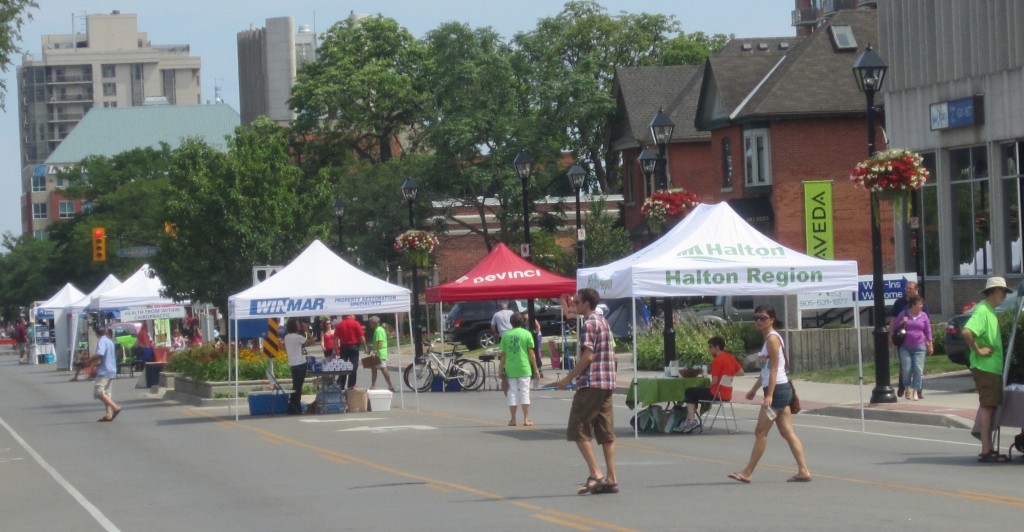 The two Car Free Sundays went well enough to try again next summer – although many of the people stuck in their cars may not think it was a good idea. The idea was to get those people out of their cars. All very good speakers – BUT, and this is not meant to rain on the Mayor’s parade – is anyone listening to these speakers; are they being heard? The city is currently looking into what it wants to do and can do with its employment lands – those properties that will hold the office buildings and high tech, high value added manufacturing operations the city needs.
Time and again we hear the consultants we hire telling council to “do your homework”. The Molinaro’s recently announced the purchase of the large lot in front of the GO station on Fairview, to the east of Wal-Mart and will be moving forward with their plans to develop the property.
During the Workshop the city held earlier in the week on the Employment Lands Councillor Jack Dennison (Ward 4) asked if maybe the Molinaro’s could be asked to include an office building in their plans. The Molinaro’s didn’t get to where they are with that kind of woolly thinking. They have already decided what they want to do with that property and have it all costed out.
That the city doesn’t know what they have planned suggests that perhaps some Council members are still using rotary dial telephones and have forgotten how to use them.
The Mayor fully understands the gravity of the problems we have and he is doing a part of the job that needs to be done. He does need to immerse himself into the talks with the developers and not leave that to the Economic Development people – nothing is getting done over there.
But the Mayor can’t do it all – the rest of us have to do our homework.
If we don’t do things differently – we won’t continue to exist.

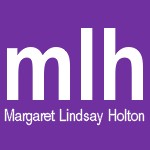 By Margaret Lindsay Holton By Margaret Lindsay Holton
BURLINGTON, ON September 28, 2012 You may recall the recent spat between the Mayor of Toronto’s brother, Doug Ford, and Margaret Atwood, famed Canadian literary icon. Aside from the eye-opening revelation that Mr. Ford had no idea who Ms. Atwood was, he and his brother, Mayor Rob Ford, on elected promises of tax cutting, were about to eliminate several community libraries. Quelle Horreur!!! The Twittersphere exploded. Facebook campaigns were hatched. Newspaper headlines joined the harangue. Canadian literati rose en masse and Ms. Atwood became their witty champion. A ‘Libraries-Are-Essential!’ REVOLT erupted.
And yet, really, have public libraries become a subsidized luxury that we, as a debt-ridden democracy, can no longer afford?
The naysayers say NO. They do believe public libraries are invaluable venues for all strata of society to not only access current information, but as research centres and repositories of our diverse social histories, local and global.
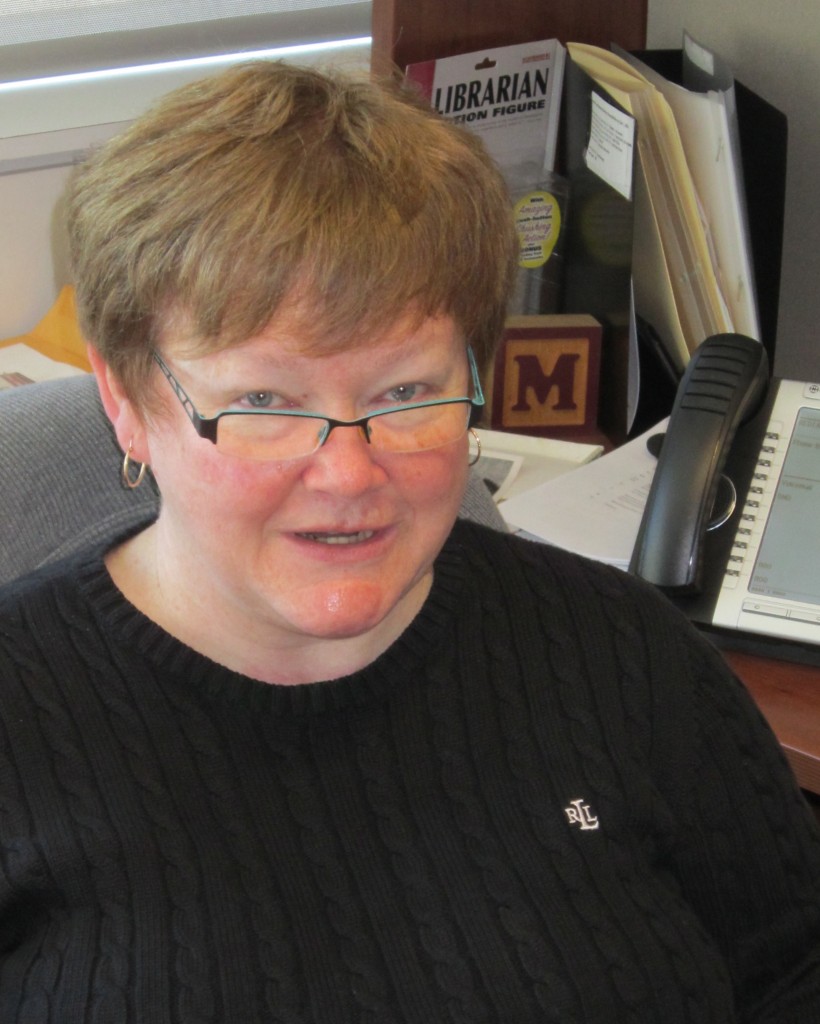 Maureen Barry, CEO of the Burlington Public Library and a consummate professional has overseen the move deeper into electronic media yet keeping real books on shelves. As Maureen Barry, CEO of the Burlington Public Library writes, “For 140 years, generations of Burlington residents have helped shape who we are and what we do.” She goes on, “Our thriving library system is a testament to the many citizens who have supported their public library as patrons and volunteers.”
Consider this. Public libraries as an IDEA of ‘free and open access to the public’ only really caught on in Victorian England. Prior to that, public access to cherished sacred and secular written texts – and a better education – was pretty much non-existent. Illiterate serfs remained illiterate serfs. Public access, of sorts, initially began during the violent upheaval of the French Revolution (1789-1799) when cleric manuscript collections and rich nobles’ private libraries were confiscated and became ‘state property’. Over 300,000 items became a part of the newly conceived national library, the Bibliothèque Nationale in Paris. “Old ideas of monarchy, aristocracy and religious authority were abruptly overthrown by the Enlightenment principles of equality, citizenship and inalienable human rights.” These principles were a natural outcome of the invention of the printing press during the 15th century. “The affordability of the printed word boosted the democratization of knowledge.” (Wikipedia) And that democratization became the cornerstone of today’s democratically inspired public library service, a service available to the general public regardless of wealth or education.
The first known library in Canada was established at a Jesuit seminary in Quebec City in 1635. The public were not allowed access. The first public library in Lower Canada was founded in Montreal in 1796, a mere seven years after the French Assembly in Paris published the first ‘Declaration of the Rights of Man and the Citizen’. The first public library in Upper Canada opened in Niagara in 1800.
It took another 100 years to build a proper public library in Burlington. But that did not stop the IDEA of a public library service taking root in this growing lakeside community within the newly hatched Dominion of Canada. Library services in Burlington began in 1872 when local public school trustees voted to spend $56 to purchase a suitable supply of books from the Toronto Board of Education. These books were placed in the reception hallway at the schoolhouse located on the southeast corner of Brant and Caroline Streets. Members, paying fifty cents a year, were able to access the collection for one hour on Friday evenings.
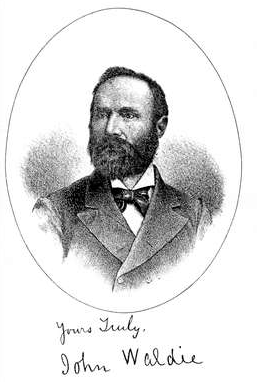 John Waldie, early library patron, was the MPP oversaw the merger of Port Nelson and Wellington Square into the Village of Burlington. It took the initiative and open-mindedness of a former local resident, of Scottish descent, to build the first ‘free’ public library. And he, John Waldie, did a lot more ‘community-building’ before he finally got around to doing that. During the course of a very successful career as a wheat trader in Burlington, then lumber merchant in Toronto, and as a re-elected MPP for Halton, Mr. Waldie was largely responsible for amalgamating the two lakeside communities of Port Nelson and Wellington Square into the Village of Burlington in 1873.
Several decades later, primarily through his broad-minded philanthropy, the first library in Burlington was built on Brant Street (on the site of the current City Hall.) It also shared the premises with the town offices and council chambers of the time.
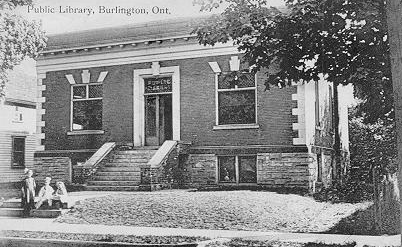 First Burlington Public Library on Brant Street, 1913. Current home of City Hall. Photocredit: Burlington Public Library Today, a 140 years later, with a somewhat staggering budget of $8.5 million (2011) allocated for staff, maintenance, IT acquisitions, and material book purchases and with a registered user base of less then half the population of Burlington, the public library could be seen as an expensive civic extravagance by the rest of the ‘unregistered’ city population. Begging the question again, are public libraries too expensive, especially in the age of the internet?
Let’s look at some other statistics provided by the library’s public relations department. In 2011, nearly 2 million items were borrowed from the library; nearly one million ‘unregistered’ patrons visited library branches; near 45,000 attended library specific programs; and over 100,000 information requests were fulfilled by library staff. All told, it would appear that this particular library, our library, for the monies allocated, is serving the regional populace very well.
There is no question though those libraries, like us, in this burgeoning internet era, have had to adapt. Today, Information Technology (IT) infrastructure at the library often consumes a greater proportion of the budget than the book acquisition fund. Within the BPL’s Strategic Plan (2012-2015) entitled: ‘The Next Chapter: Thinking Outside the Books’, the BPL intends to further improve functionality and accessibility “by upgrading the core computer system”. The new reality is that we are all increasingly ‘plugged in’. Like it or not.
In Alberta, city libraries charge patrons anywhere from $5 to $20 a year for library cards, but in Ontario, the Ontario Public Libraries Act forbids charging money for access to a library or for borrowing books. There are, thus, few other options for generating revenue aside from taxes. All the more reason for the BPL to provide exemplary ‘connected’ library services to the tax-paying ‘plugged in’ public.
Many would argue, (myself included), that libraries, regardless of spiraling IT and staff costs, continue to provide an irreplaceable democratic role within our young Canadian society. To close them in the name of the ‘global’ internet, would not only close access to those who cannot afford purchasing a private library or pay for monthly internet access, but closure would diminish the nurturing lifeblood of local vibrant communities. Communities coalesce within the ‘free and accessible’ democratic framework of library branches. Public libraries are fundamentally a democratic institution. And one sign of a diminishing democracy would be the closing of community libraries.
It is hard to imagine the lack of an element that we take so much for granted today: electricity. This means of illumination only became available to the general public at the beginning of the twentieth century, (about the same time that Waldie donated thousands of books to form the backbone of the Burlington Public Library.) Today, we plug in, bounce around on WIFI, and unthinkingly consume megawatts of purchased electrical power to illuminate our expensive laptops and computers. Primarily, we use this bought power to read items for work, school or pleasure: briefs, newspapers, text messages etc, and increasingly, e-books. But, worth asking, what happens if the power goes out, or, Harper forbid, the economy collapses? Communities, without the resources of their public libraries, would suffer profoundly.
Free e-books were first developed in 1971 by the late Michael S. Hart, founder of Gutenberg.org. More here:
The greater question remains, can we, as Canadians, AFFORD public libraries? The time and money we privately expend on consumer-electronic portals is far greater than any we physically devote to our library. Likewise, some would say that television, YouTube and the ubiquity of photo imagery – (‘A picture tells a thousands words’) – have usurped literacy altogether (a la Doug Ford).
 Child reading And yet, on closer examination, it is clear that the fundamentals of literacy remain the same for all times and for all ages.
Creating strong narrative arcs to teach and to guide, and using potent language effectively to inform and advise, are the results of a solid education grounded in the basics of reading and writing. Learning how to think is built on the constructions of other’s better words. Their thought-filled written scripts funnel our curiosity and creativity so that we, in turn, develop new insights and pass on our know-how. In that regard, the story-telling cuneiform clay tablets of Sumer dating back to 2500 BC really are the antecedents of the trendy ‘tablets’ of today. The difference is that ‘being literate’ now involves additional skills beyond reading and writing: one must also become computer literate.
As much as the internet does increasingly pre-occupy our time, attention and money, a successful public library providing popular library services – as a kind of ‘out reach’ extension of a nurturing public school system – continues to constructively guide our ever-inquiring minds. As many also well know, a well-directed search or inquiry through the library is a welcome antidote to the growing anxiety iDisorder of ‘E-Information Overload’. The library has an information service many find useful: – Just Ask-a-Librarian: It is not surprising that the Burlington Public Library website was visited over 1.5 million times last year. That works out to over 4000 ‘hits’ per day. Yes, active minds seek answers.
Rather than redundant or too expensive, public libraries have become increasingly necessary filaments that maintain the democratic ideals espoused by our freedom-fighting democratic forefathers. Without them we would also become increasingly disenfranchised from the roots of our very real earth-bound communities. As vibrant hubs of community service, public libraries today provide much more than free access to current newspapers, periodicals, CDs, DVD’s and books. They also offer early reading programs, computer access and training, literacy tutoring for children and adults alike, and a safe haven for ‘intellectual freedom’. Altogether, they augment the basic tenets of our democracy.
The mission statement for the Burlington Public Library states, “Enriching Burlington by supporting 21st century literacies, lifelong learning, and community connections.” Yes. That is what they do. As Ms. Maureen Barry so aptly writes, “Our public library is truly a dynamic civic commons. “ Yes, that is what it is. All the more reason for us, within the larger community, to continue to support and promote it. Because, as much of the rest of the war-torn and weary world knows: if we don’t protect and use this hard-won democratic ‘freedom’, we just might lose it.
Fiscal prudence and long term accountability must, of course, be continuously evaluated and considered. Cutting back on some library services might be necessary in the days ahead, but never, ever, must we contemplate cutting out our public libraries completely.
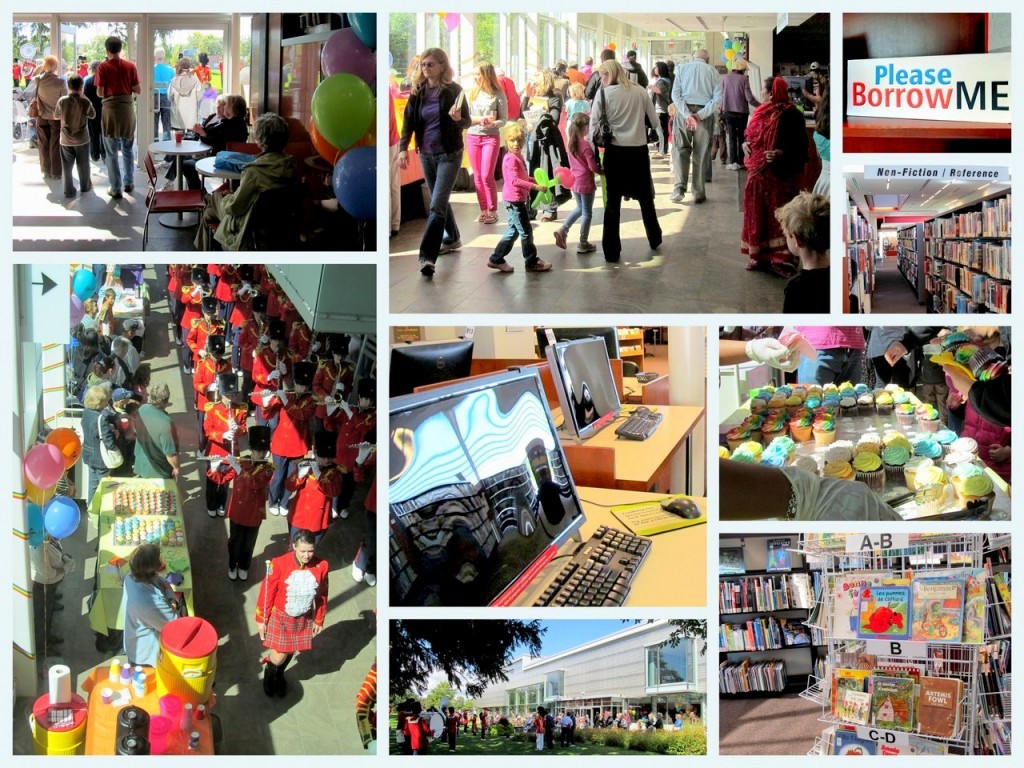
And now, a bit of fun.
The Top 100 Books of All Time.
For those who prefer non-fiction: The Top 100 Non-Fiction Books of All Time –
Better yet, JOIN The Burlington Public Library.
It is FREE, still, for those who live, work or pay taxes within Burlington.
Also coming up at the Burlington Public Library on September 29th: The Human Library. Eleven men and women, of diverse backgrounds, some from oppressive totalitarian regimes, use the ancient arts of ‘story-telling’ and dialogue to break down barriers of prejudice that have shaped their lives. Their stories of disenfranchisement – and ultimate survival – continue to open our minds to the challenges of our ever-evolving humanity. Book your half hour with an engaging living person.
These stories remind us all of the on-going preciousness of an open-minded community-orientated democratic public library service in Burlington, and in Canada.
Margaret Lindsay Holton is both an environmentalist and a community activist. She is an artist of some renown and the designer of a typeface. She is also a photographer and the holder of opinions, which are her own, that she will share with you in an instant. She appears as an Our Burlington columnist every two weeks.

 By Pepper Parr By Pepper Parr
BURLINGTON, ON September 12, 2012 The first run was in 1980 when the city raised $4000 for the Terry Fox Research Foundation and a cure for cancer.
More than 1000 people were out on the pathways at Beachway Park and running through Spencer Smith Park.More than 100 volunteers helped people with massages, warm up exercises, giving directions and handing out glasses of water.
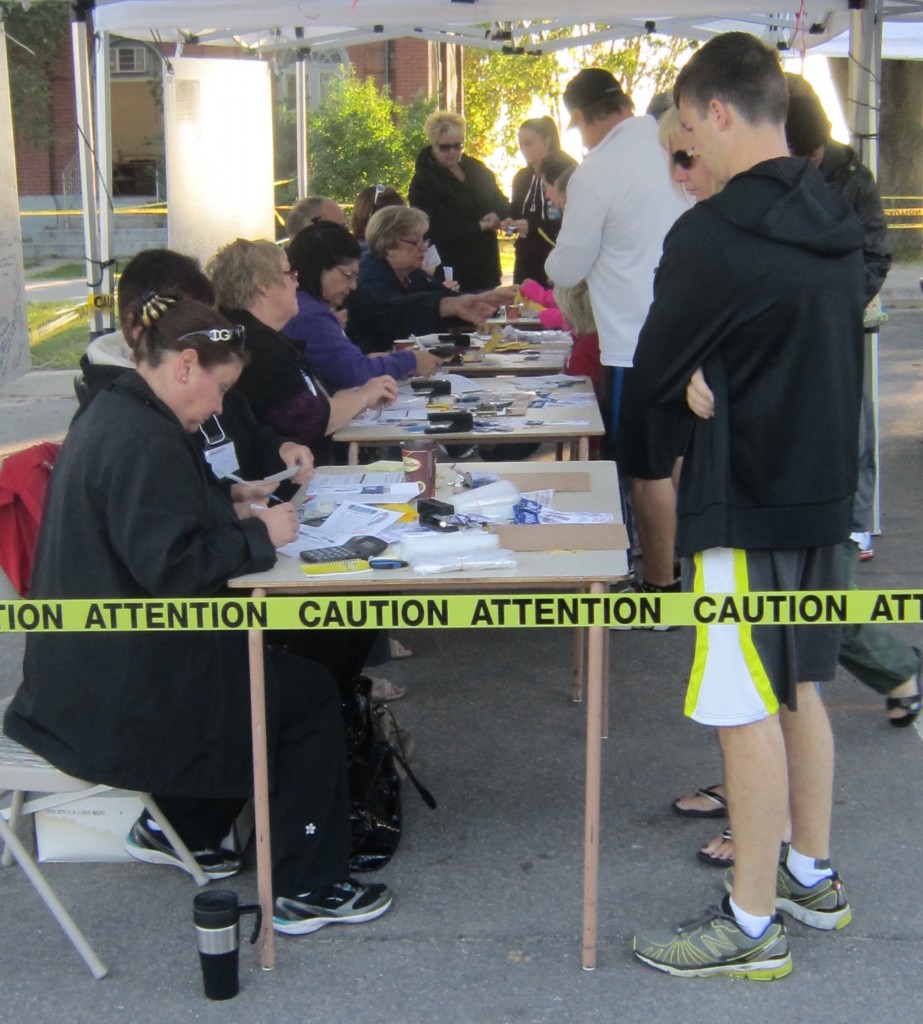 These are the ladies that collected the funds raised. One family came in with more than $1600 raised in their community. We will have the final count later in the week. We will know later in the week how much was raised in 2012. The total raised since 1980 in Burlington is now over $1.4 million.
Who would have thought that 32 years after Terry Fox had to abandon his run across the country using an artificial leg, that we would have hundreds of people coming out every year to run for a cause.
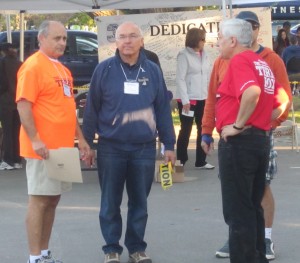 Don Carmichael, chair of the Terry Fox run in 2012, meets with part of his team to go over the final check ins before the event gets serious and the crowds begin to show up. Many, perhaps even most of the people who ran today were not alive when Terry Fox did his run. I heard about a one legged man declaring that he was going to run across the country when he dipped his artificial leg into the Atlantic ocean and headed west. It seemed like a bit of a stunt to me – I knew nothing about the man.
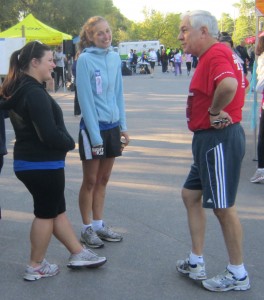 It was a little nippy in the morning, the kind of weather that helps the leaves turn colour and keeps people shivering just a bit. That changes when they begin their run. I was sitting in an office window watching Terry Fox run with that half limp, half trot of his as he headed south and into Nathan Phillips Square where more than 100,000 people were on hand to greet him. This was no stunt.
The fund raising drive, which hadn’t done all that well when it worked its way through the Maritimes and Quebec, picked up momentum as the national media picked up the story in Ontario and from that point it just took off. There were close to nightly news reports with a summary at the end of each week. The country was mesmerized by what this man was doing.
Eight years earlier Canada came together as a country when a Canadian Team beat the Russians in a closely fought hockey series. We had a sense of who we were after that and when Terry Fox caught our imaginations we had no trouble getting behind to help.
The country almost automatically made the project theirs and we’ve been doing that ever since we lost Terry Fox in 1981
He was born Terrance Stanley “Terry” Fox, on July 28, 1958 and was made a Member of the Order of Canada. There is much more to the Terry Fox story than this. Follow the Burlington event and the young man`s story.
Part 2 of the Terry Fox story and the Terry Fox run; a photo feature.
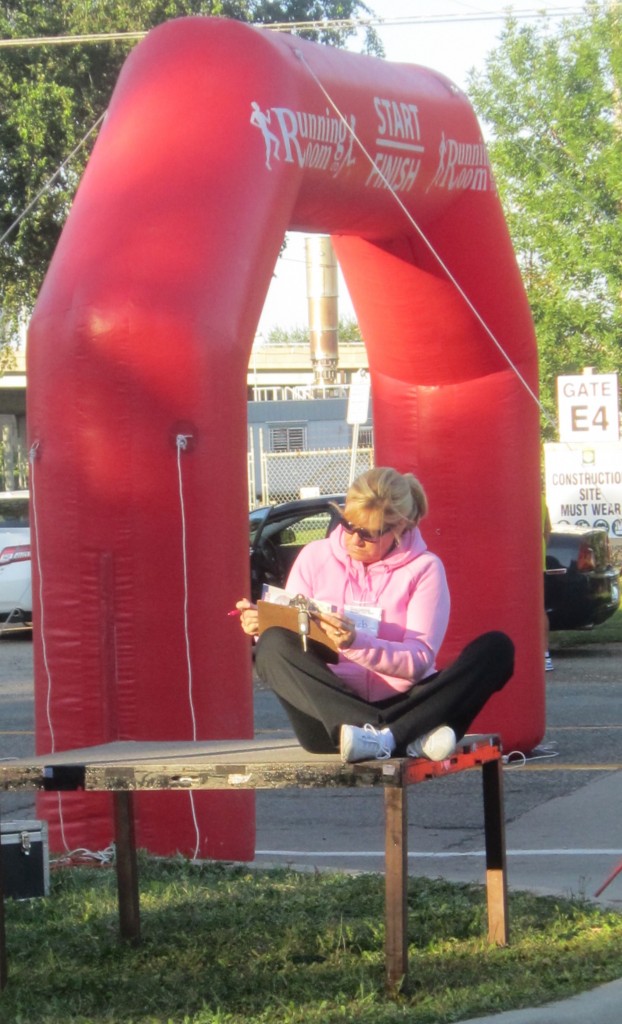 Deb Tymstra MC’d the event – her second year doing that job. Here she goes over her notes to prepare for an event that almost got out of hand when the Casey Cosgrove supporters were gathered to have pictures taken. That crowd was so large that it held up the Bikers and the Walkers who Tymstra wanted to get started. She managed the chaos. 
 By Pepper Parr By Pepper Parr
BURLINGTON, ON September 12, 2012 There they were, out on the field, grunting, running, stretching their limbs – more than thirty of them practicing as the Bateman High School Senior Football team.
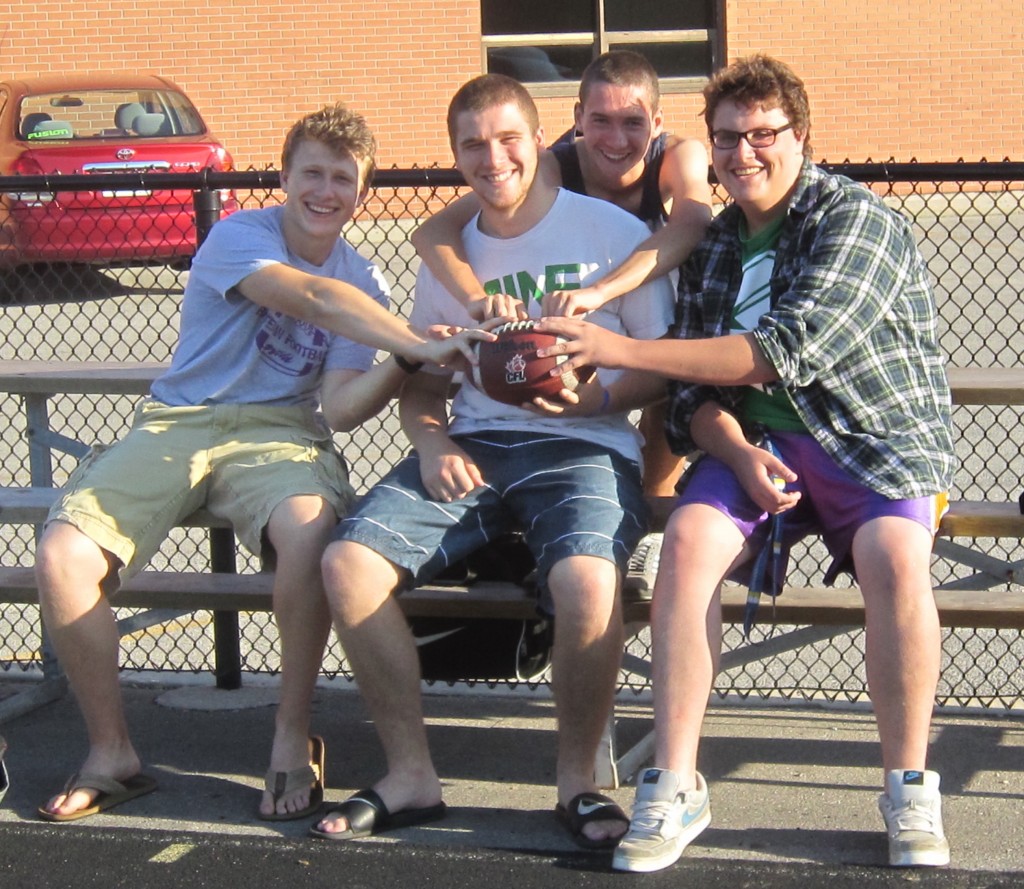 The protesting team – from the left: John Phelps, Chad Doan, Kennedy Dyet and Chris Bishop. When the football players learned their team had been scrubbed from the football schedule they took to the streets in protest. They made their point and the football team is back on the field. Now they might have to deal with a teacher work stoppage. They had to protest to get there – but after a part of a day out on the street waving signs and seeking support for their team – they were back in business.
No one remembers when there was a demonstration by students at Bateman before and it took courage to make the decision to protest when they learned that their wasn’t going to be a Senior Bateman football team on the field for 2012.
Chris North sent an email to Our Burlington – we ran with his letter and followed up with a visit to the school to see how the protest and demonstration went. While there, we saw some student behavior that was great, we saw kids talking in groups the way students around the world talk in groups and we saw students that were behaving – let’s be blunt about this – it was just plain dumb behaviour. We certainly heard about that from more than 45 students and the parents of students. That’s all part of an interactive process where people get to say what they think. We will comment on how that went later in the week.
This piece is about the football team – the guys that decided they weren’t prepared to see their team disappear from the roster. Chris Bishop led the group that was made up of Chad Doan, Kennedy Dyet and John Phelps. All are back at Bateman doing an additional year to upgrade their marks. All have clear plans to attend university with a pretty good idea of what it is they want to study.
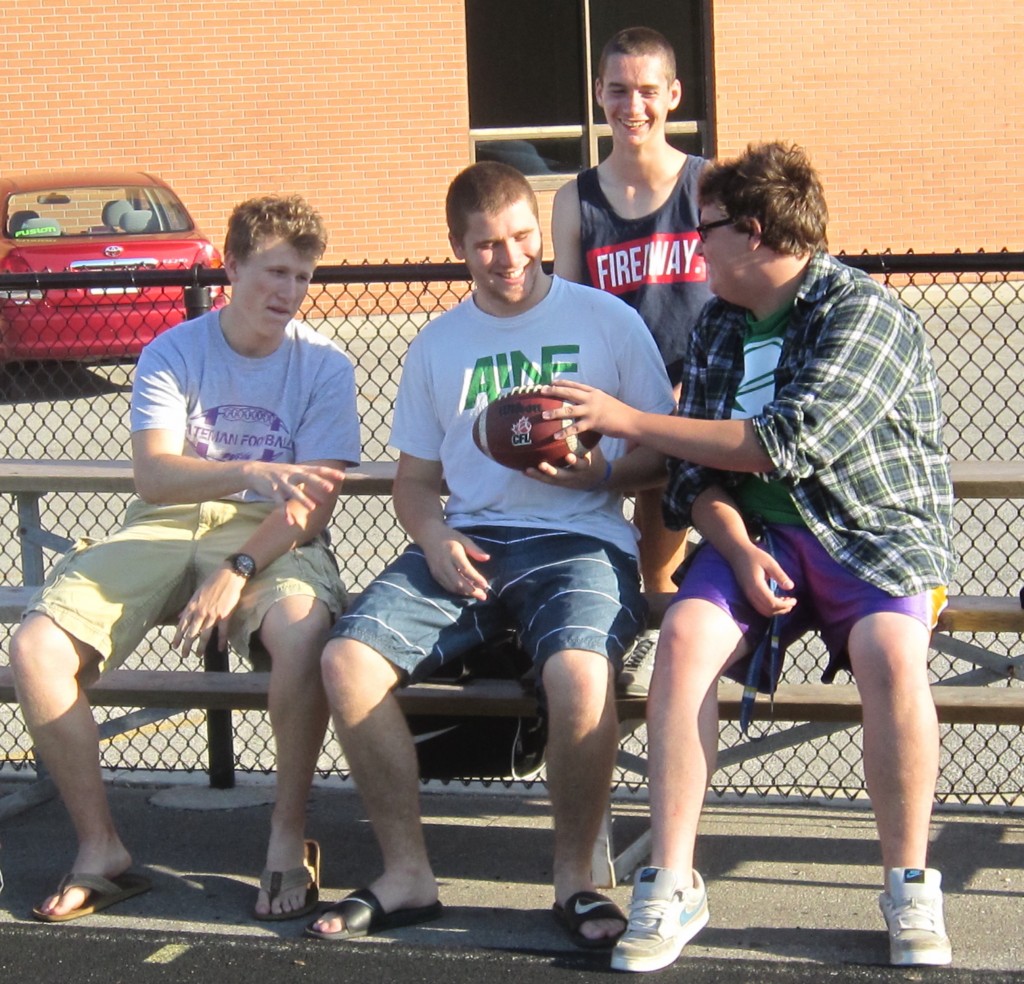 Four high school football players who felt their team was wronged and took to the streets in protest. They made their point and are now back on the football field. Gotta be at least eight proud parents out there. From the left: John Phelps, Chad Doan, Kennedy Dyet and Chris Bishop. Doan wants to study psychology. “I’m interested in the way people behave and want to learn more about that”, said Doan, which led to questions about how the school administration behaved when they decided to shut down the team.
Chris Bishop thinks he wants to study criminology and maybe look into law. Another student wants to study sports management.
The students felt they were told it would be “impossible” for a senior team to be put together and so they were scrubbed from the schedule.
“They had a mind-set and didn’t think we could field a team” said Dyet who coaches a team in the Burlington Minor Football Association.
These four young men didn’t see it that way. They believed they could mount a team but, just as important to them was the rule that would mean there would be no team playing the following year if they did not mount a team this year – and these four young men didn’t want to see that happen to those that would follow them.
Kennedy Dyet wonders why they had to protest. “We were told there was nothing they could do for us” but once the protest was underway the principal of the school met with the football players and asked how he could help.
It looks as if the Phys-ed people had given up on the students and pulled the team from the schedule. The students say they weren’t told the team was being pulled. There was clearly a lot of energy and enthusiasm on the part of at least some members of the team, which when identified, moved the administration to get behind the students. Now the football players have to get the school behind the team and begin winning some games.
On Tuesday evening there were 29 seniors out on the field – huffing and puffing through the exercises. It looked like a good workout from the side lines.
The Bateman Seniors are a Tier 3 team – they want to move to at least Tier 2 and see Pearson and Aldershot as the schools they have to beat. “We’ve got six to seven regular games in the season” explained Dyet “and then the semi-finals.
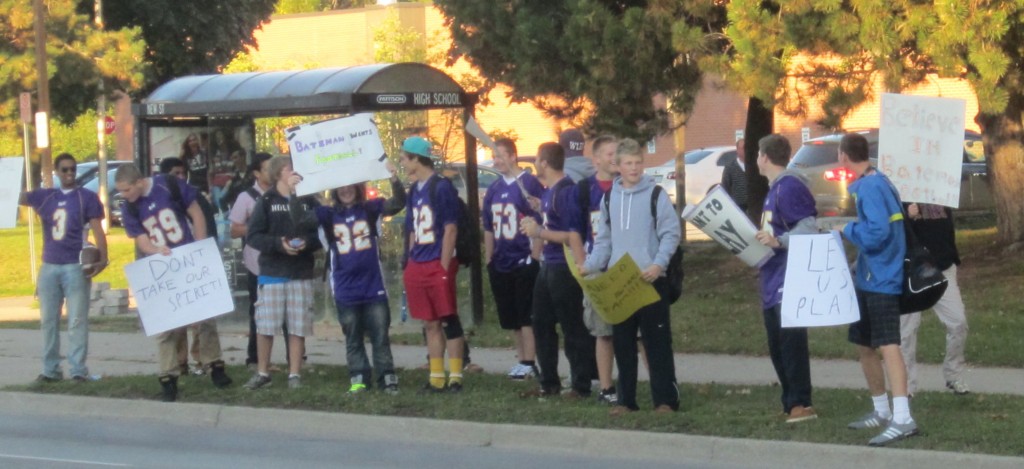 Football team protests the scrubbing of their team from the schedule. Administration changes its mind – team out practicing – next they have to win some games. Chris Bishop feels the support they need is now there for them within the administration but also feels that it wasn’t there for them before they hit the streets with their signs. “The principal did meet with us at the Bistro and asked us what it was we wanted and we told him we wanted our team on the field. “Mr. Heffernan said he would do everything he could to help us – that’s all we wanted” said Bishop.
Kennedy Dyet added that the volleyball players are battling for a program “and we think what we’ve done will help them get what they feel they deserve.”
“We had faith that we could make out point” added Dyet “and now we have to do the hard work.”
The players commented on the new coaching staff they have. “These guys have great history commented” commented Chad, “one of our coaches was with Team Canada.”
Is there a problem with the commitment level on the part of the phys-ed staff and the school administration at Bateman? May have been. Had they given up on their students and as Kennedy put it, brought a “mind set” to the table that prevented them from seeing what the students wanted and what they were prepared to do.
Will the “no strike” legislation the provincial government has passed impact this football team that has shown it wants to be out on the field playing the game. Are teacher politics going to get in the way of the educational process the way it did in when the Mike Harris government was battling the teachers?
The young men we talked to were polite, focused, left me feeling there was a clear sense of purpose and an objective they had thought through. I came away with the feeling that there are eight proud parents out there somewhere.
The task now is to develop and condition their team and support them with enthusiasm that provides the energy and that extra bit of “make it happen” that a cheering crowd can give a team. All four young men know exactly what a cheering audience can do for athletes.
Go Wild!

 By Pepper Parr By Pepper Parr
BURLINGTON, ON September 11, 2012 After many months of keeping everything under wraps, Jeremy Freiburger finally opened the curtains and is letting the public see what the three Burlington judges have chosen as finalists for the public art that is going to stand in front of the Burlington Performing Arts Centre.
Burlington is slowly learning that if you want the public to buy into an idea – let them know what you are up to; ask their opinions and listen to what they have to say.
You can view models of the three finalists at the Central Public Library or see large photographs at City Hall and Tansley Woods – and that is about as far north as the public viewing will go. Something for the city to look into – the people north of Upper Middle Road are just out of luck when it comes to knowing much about what goes on at city hall, unless they want to drive well outside their community
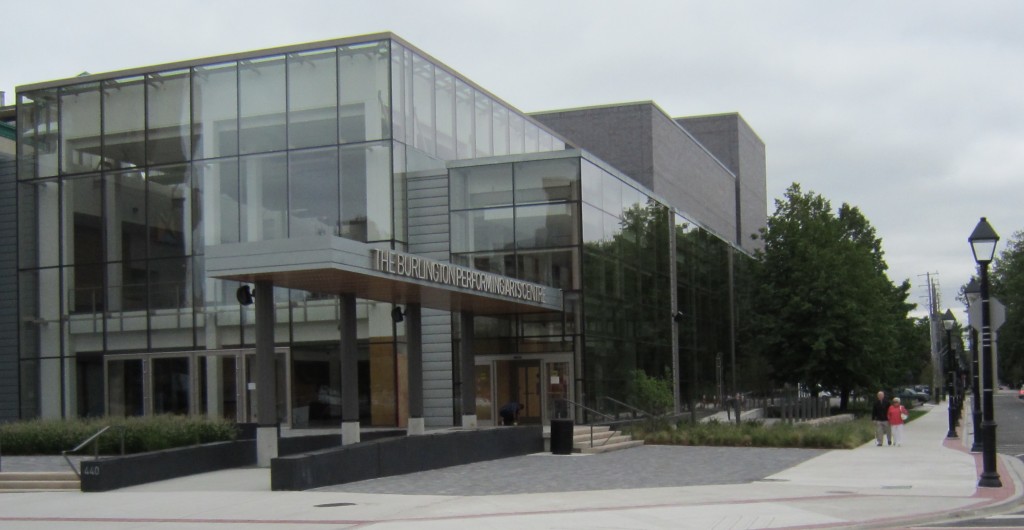 The currently unadorned Performing Arts Centre may soon get some public art. The plans are to place the art in the small fore-court – shown in the right of this photograph. Art is a very subjective thing. Many people feel that they know what they like the moment they see it – and that is certainly true. But taste is something that is developed; something that evolves over time. That development takes place when you see and experience different forms and examples of art. Some feel that public art should come from within the community – others feel the search should be world wide.
The judges are: Ian Ross, executive director of the Burlington Art Centre, Emma Quinn, executive director of the Ontario Craft Council, Trevor Copp, artistic director of Tottering Biped Theatre, Natalie Eldershaw, 4th-year Sheridan College art student.
The steering committee that oversaw the process included: Avery Brooks joiner – local youth involved in Culture, Dan Lawrie – project donor; Brenda Heatherington – BPAC Executive Director, site stakeholder; Mary-Ellen Heiman – member of BPAC Board and Denise Beard, Acting Manager of Community Development Services for the city of Burlington
The three finalists, chosen out of the 119 submissions to the Call for Submissions the city put out in March of this year, were asked to then create a small model and provide some detail on what they proposed to create.
Those models are now on display at the library on New Street
The project got its start when Burlington businessman Dan Laurie expressed an interest in sponsoring some public art that would be placed in front of the Performing Arts Centre, at the intersection of Elgin and Locust streets in downtown Burlington. Laurie put up $37,500 of his own money and the city used $75,000 from its Public Art Fund
The Cooke-Sasseville submission, Stay Connected, is made of stainless steel; aluminum; powder-coat paint. It is 15 feet high x 27 feet wide.
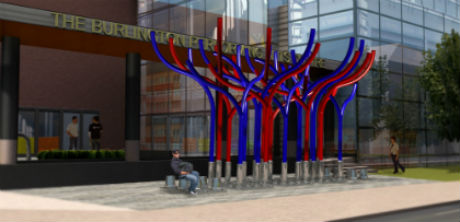 The Cooke-Sasseville submission is certainly the most colourfull of the three. How will the bright colours stand up to weather over the long haul? In explaining their submission Cooke-Sasseville had this to say: “We are proposing the creation of a monumental and playful sculpture that stems from the idea of representing, on an exaggerated scale, a well-known, easily identifiable object that is closely tied to the performing arts: a technical console and connecting cables. Our proposal is visually striking and evocative in its usage of space and it will transcend the objects that it represents, becoming an almost abstract work that brings to mind both vegetation and the human circulatory system. The work will be firmly fixed to the ground and expand into space in a systematic manner, schematizing a perfectly orchestrated choreography where the notions of movement, exchange and transmission are represented.”
“The work that we are submitting suggests a never-ending openness towards the sky and it may be interpreted in many different ways, from the simple representation of everyday objects to the schematization of complex fractals. In doing this, we wish to glorify that which may seem banal but which is really essential, or that which is not seen but which plays a crucial role in the creation of major artistic productions: the technical side of the production as well as the importance of collaborations, human contact, encounters and communication.”
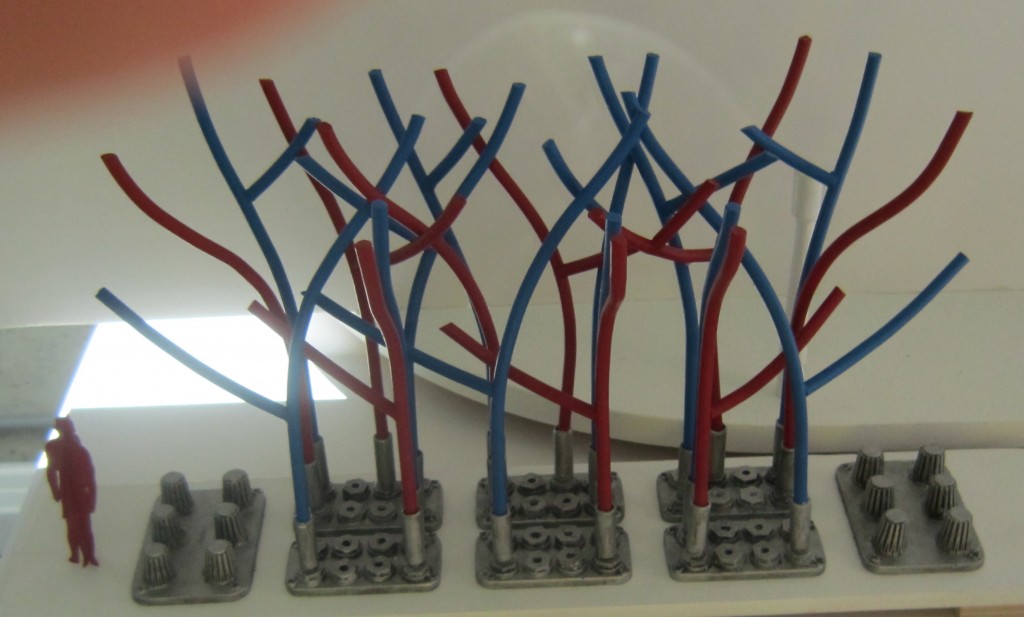 A scale model of the Cooke-Sassville submission. These Quebec based artists have done a significant amount of public art work throughout North America. The Peter Powning submission, Spiral Stella, is to be made of stainless steel; cast bronze and stand 16 feet high and be 30 inches wide.
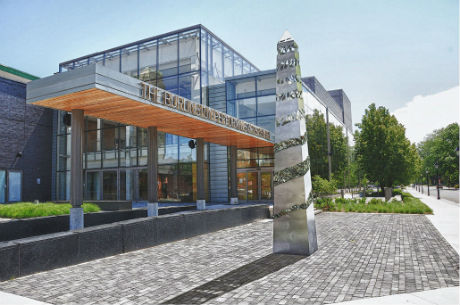 The Spiral will be 16 feet tall and include in the bronze casting artifacts from the community that could well make this one of the most intriguing pieces of art in the city. Powning explains his submission this way: “My intent with this proposal is to produce an iconic sculpture of scale that has impact from a distance but which also provides an intimate experience up close. I propose a sculpture that offers an opportunity for discovery, an enhanced sense of local identity, and education opportunities; a community touchstone honouring Burlington and the Performing Arts Centre; its history, natural environment, culture and identity. A key element of this project will be community participation in providing important cultural and historical artifacts to include in the cast bronze spiral. I think of this bronze relief as cultural mulch, incorporating artifacts from the historical to the contemporary.”
“The elements I will be working with are meant to balance content and form in a dynamic approachable sculpture. The obelisk will reflect the sky, patterns of cloud and ambient light, changing hues as the day progresses, the cast bronze provides visual and textural contrast as well as an intimate tactile experience. The formal obelisk shape organizes the various parts of the sculpture in a unified, recognizable whole. In close proximity, it reveals a material richness with layers of cultural content gathered from the people and institutions of Burlington in cast bronze relief. From a distance, this monumental sculpture will be visible as a landmark.”
 The section that appears in blue is the part within which the artist will include local artifacts. No one knows at this point what will be included if this submission is chosen – but if it is chosen – expect everyone in the city to come up with something – it’s going to be out there for everyone to see for at least 50 years – perhaps forever. What doesn’t become immediately evident in the artists comments is that the people of Burlington will contribute a large part of the Spiral – and he has no idea what the public contribution will be. Somehow, what people want to see included in the spiral will get to the artist who will include it in the final structure. That could be very informative and certainly reflect the community.
Aaron Stephen calls his submission In the Round which will be made of cast zinc alloy; architectural zinc sheet and have a diameter of 28 feet.
 The In the Round submission is far more complex, and intriguing, than evident in this picture. That globe graphic is made up of more than 15,000 small figurines. Interesting approach but the location and the height of the art will need some consideration. “In the Round”, says the artist, “is composed of over fifteen thousand small human figures traversing the wall of Burlington Performing Arts Centre’s fly tower. Each three-inch metal figure interacts in a unique way. Some mill about, some talk, walk, or just look around – simply depicting a crowd of individuals interacting as we do in everyday life. From a distance the minutia of this crowd disappears while a larger whole becomes apparent. Each individual figure acts as a pixel defining the collective image of a twenty-eight foot world globe.”
“Anyone who has attended a live performance has experienced the curious moments that immediately precede the actual event. In the lobby, crowds mill around and everyday conversation takes place. There is a unique energy in the air that can only be described as communal anticipation. The evening takes a turn as the performer(s) appear on stage. In a brief moment, what previously seemed to be a haphazard group of audience members becomes a single entity.”
“Like the distinctive beginning of a live performance, In the Round encompasses the same feeling of anticipation, movement, and energy. It represents the moment in which the community of Burlington becomes fully engaged and implicated with those on stage.”
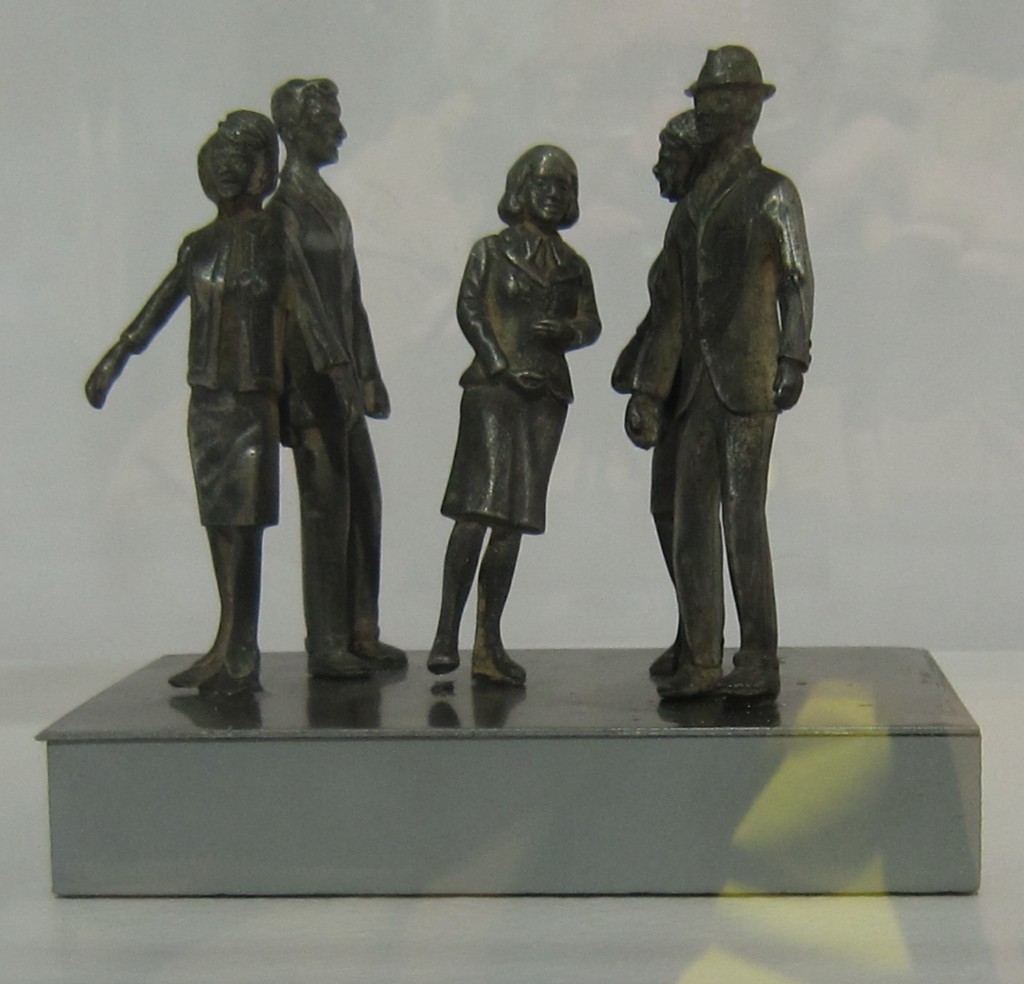 Examples of the more than 15,000 figurines that will be used to shape a graphic of the globe in the In the Round submission. The “official” illustration doesn’t do justice to this submission. That it will be at the back of the theatre is a limitation. What is shown in the official picture is a graphic of the world – what you don’t see is the 15,000 little figures that will make up the globe.
All three submissions have merit. Several are unique in the approach they use to involve the person looking at the art.
The city has asked the public to “Tell us what you think!” and have provided a place on the city web site for comments on all three pieces of art. Log into WHERE and tell the city what you think. If you can – get over to the Library, and look at the maquettes (fancy word artists use when they really mean to say a model of what they have in mind)
There are also ballot like forms upon which people can write their comments.
The judges will review the comments and come to a final decision. That final decision doesn’t have to be the selection of a specific piece of art.
The three judges chose three submissions – they could have chosen five or ten but there wasn’t enough money in the budget to give every artist the $1500 grant to prepare the model.
Once the judges go over all the comments they will decide which of the three submissions should become the art that will be placed outside the Performing Arts Centre. The judges do not have to choose one of the three finalists – the decision they make will depend on the public feedback.
The challenge for the judges is – are they going to lead public opinion and help shape it or are they going to follow public opinion. Attempting to lead public opinion in Burlington is not always a rewarding endeavor.
If public opinion is strongly against any of the three submissions the judges can decide that none of the three put forward is what the public wants. What do they do then – and why were just three of the 119 submissions selected?
The selection process had two parts to it. First review everything that came in and then invite the three the judges thought were the best and ask them to prepare a model of what they were proposing. Each artist was given $1500 to build their mode. There wasn’t enough in the budget they had to work with to invite more than three.
This is the second major public art project for Burlington. The “orchids” ,done by Irish artist Alex Pentek, were liked by many – but just as many couldn’t understand why it was placed in the middle of busy Upper Middle Road, where it is extremely difficult to see the art as you duck under the railway overpass. Very poor location.
The Performing Arts Centre is seen as a prime public site and with the right art it will be something people will come to see; providing the city selects what the public is prepared to accept.
Make a point of getting to the library to look at the models. And let the city know what you like and don’t like – and add why you like what you see as well.

 By Pepper Parr By Pepper Parr
BURLINGTON, ON September 10, 2012 The team was supposedly shut down because they couldn’t field a full squad – but that wasn’t the way the Bateman Wilds saw things so they took to the streets with an early Monday morning sidewalk protest in front of the school.
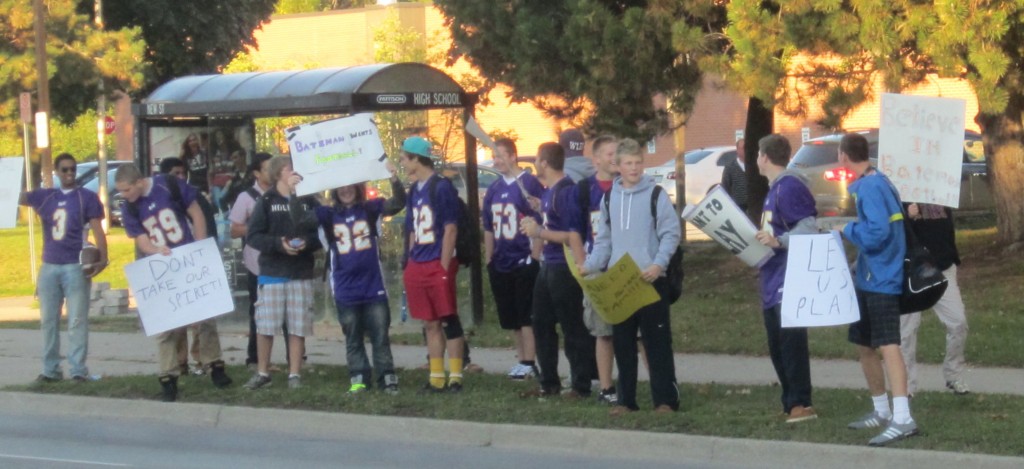 Bateman High’s Phys-Ed staff didn’t think the school could field a full squad and took steps to cancel the fall program. Football players took to the streets in protest Chris Bishop – certainly a football player given his size, was the spokesperson for the group and the person who sang the team cheer the loudest.
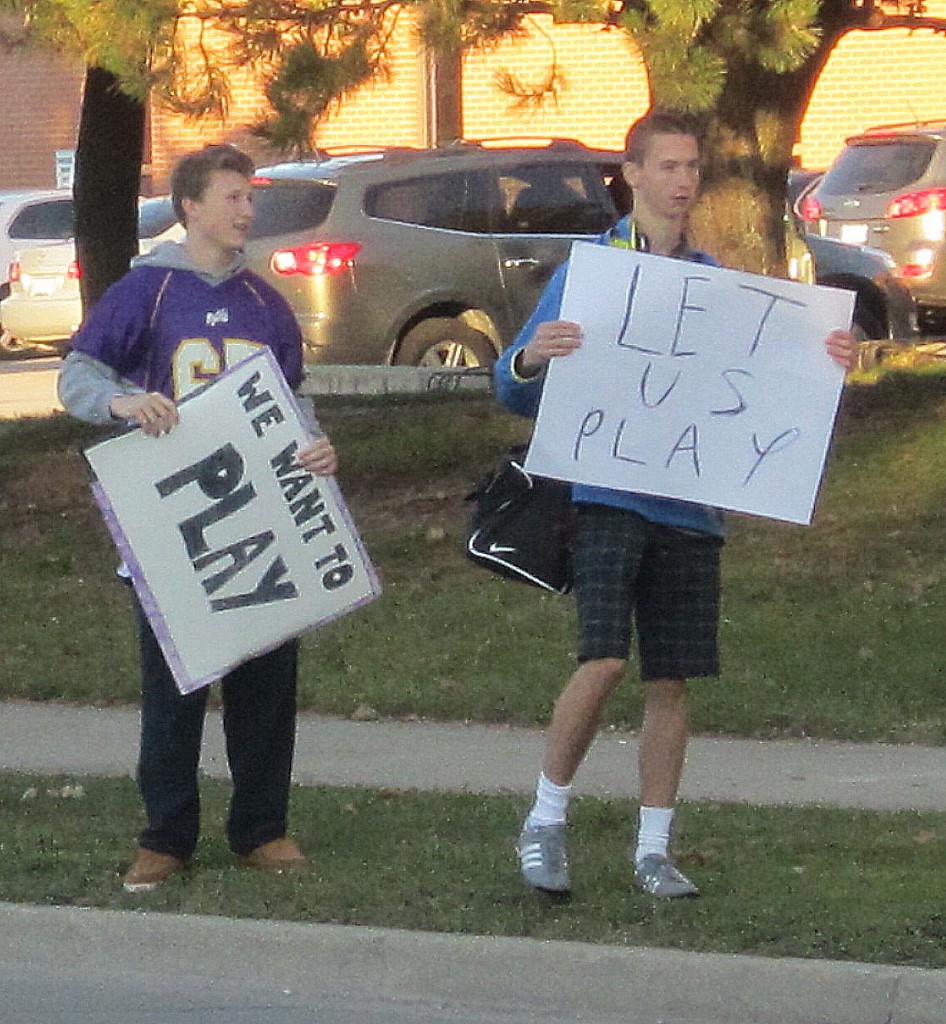 There are teachers at Bateman High that would like to see this much effort IN the classroom. The football players take their message to the streets. If a football squad needs 30 people, there were more than 30 enthusiastic students out there this morning. `We`re here for the day” explained Bishop, as he headed back to the fellow football players on the side walk exhorting every car that passed to honk their horns in support.
Bishop added that “if you put enough pressure on something there will be a change” and he fully expects the staff at the high school to rescind the decision.
Bishop thinks the school didn’t give the football players the time they needed to pull their team together and feels they acted a little too early in shutting them down.
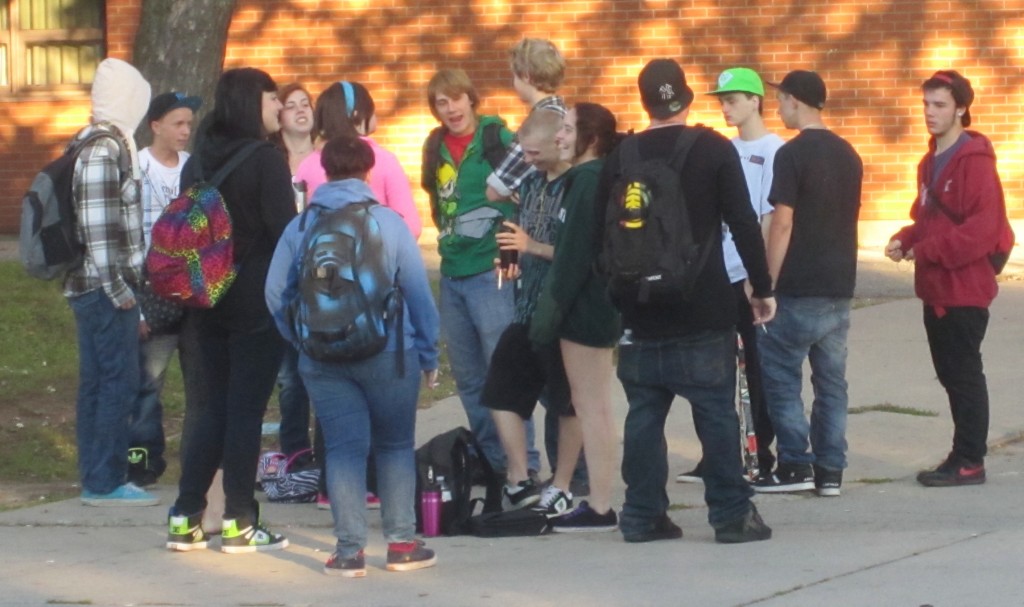 Not everyone at Bateman High focuses on football. This crowd, steps away from the protest, chats away before time to get into a classroom approaches. Different folks – different strokes. Bateman High, located on New street east of Appleby Line is your typical large school where cars stream into the driveway to let students out and buses slip in and out efficiently.
Many of the students knew nothing about the football protest. Like any other suburban high school there are different groups; the “fashion plates” are easy to identify; the geeks not so easy but they are there. The women on the field hockey team with their sticks in hand as well as the “couple” that have something going.
The chatter between the different groups is loud at times, but not unduly so. They carry a lot of books in those bags on their shoulders.
They stream off the bus that stops in in front of the school and all seem to arrive in large bunches.
 Female student casually dropped the donut wrapper on the ground and puffed away on her cigarette while enjoying her coffee. The wrapper, shown on the right, blew away into the street. Not the best or the brightest at Bateman High. There are the “cool” ones; the slightly older crowd who, the morning I was there certainly weren’t anything to be proud of. The smoking was bad enough – don’t they read? – but the blatant littering – one swishy female student just dropped the donut wrapper on the ground, while another cool dude with the crowd kept spitting on the sidewalk. They certainly weren’t representative of the crowd; this lot did little for the schools reputation.
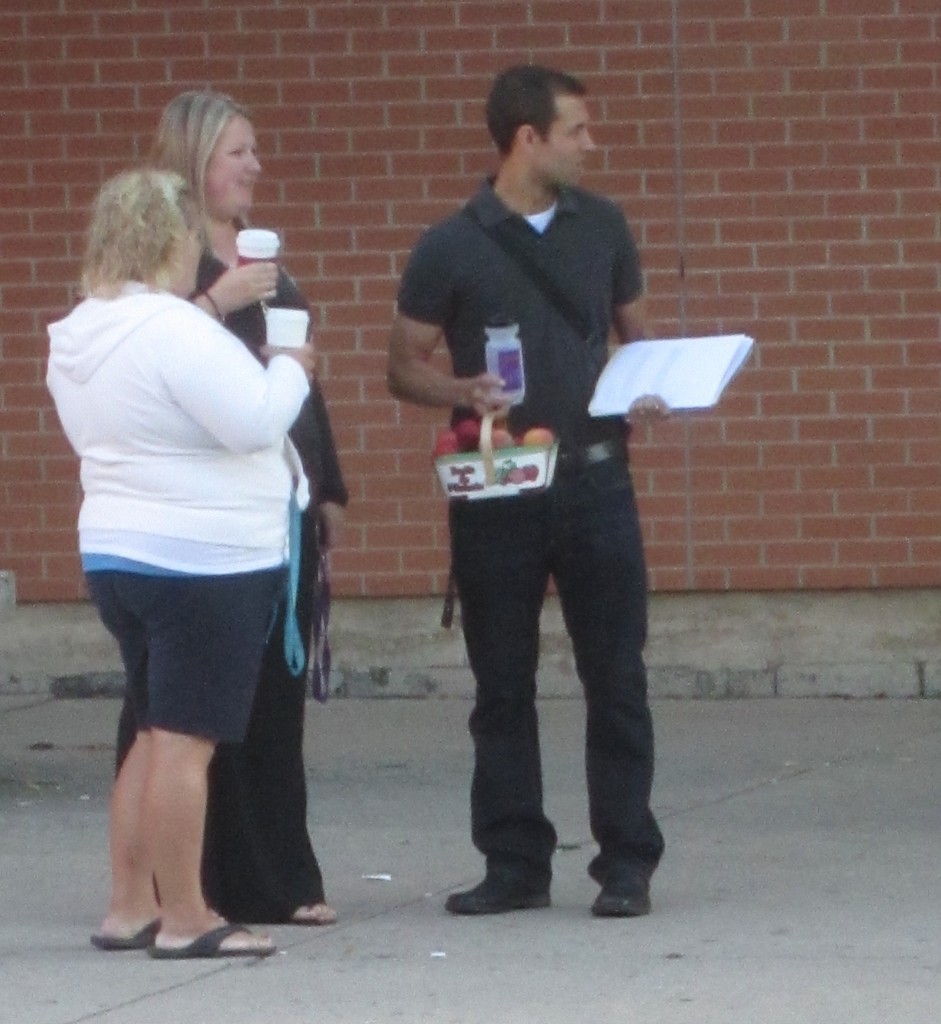 Bateman High staff look on as student protesters wave their signs and tell their side of the story. Can staff and students work this out? Will the Bateman Wild be on the field this season? Stay tuned The football players planned on being on the street for the day. At some point they will meet with the principal and the Phys-Ed people and work out a solution. Someone in the Phys-Ed department is wishing the students had shown this level of enthusiasm earlier in the football season. First practice is a couple of days away. Will the “Wild” be on the field? In strength?
Could this kind of enthusiasm take them to the finals?

 By Pepper Parr By Pepper Parr
BURLINGTON, ON September 8, 2012 – This is a dodgy subject; what do you say when you learn that someone you know took their own life or that a member of a family you know well committed suicide. You’re stunned and you wonder if there was something you should have done, could have done. And what do you do now?
Society is at least talking about suicide. The Region of Halton is partnering with the Talking about Addictions and Mental Illness (TAMI) program to offer two community forums to help break the stigma associated with suicide, help people to talk openly about suicide, and show how everyone has a role to play in suicide prevention
Personally I’ve never understood the stigma sometimes attached to suicide – these are family tragedies that need the help, compassion, understanding and support of the community to be part of the healing.
 There is a point where utter desolation becomes more than a person can handle. An understanding of what depression is; what it does and how best to cope with it is part of the process. Ignoring it or even worse stigmatizing it socially just drives this very real problem underground where we can’t deal with it .
Monday, September 10 is World Suicide Prevention Day, and the Halton Suicide Prevention Coalition (HSPC) is partnering with the Talking about Addictions and Mental Illness (TAMI) program to offer two community forums.
Both events will be running from 7:00 – 9:00 p.m. on the following dates and locations:
September 10: Holy Trinity High School – Theatre, 2420 Sixth Line, Oakville
September 13: Craig Kielburger Secondary School – Auditorium, 1151 Ferguson Drive, Milton
Suicide can be a difficult subject to talk about and that often stops individuals and families from reaching out for support. Regional chair Gary Carr adds: “That’s why I think it’s wonderful that both the Coalition and the TAMI program are coming together to help reduce the stigma and use World Suicide Prevention Day as an opportunity to open the dialogue.”
 “I am sure the event will be powerful as those who attend will hear from both a professional from the HSPC and a speaker sharing his personal experience with suicide. I’m also looking forward to attending the Coalition’s annual general meeting (AGM) on November 9 where Mr. Bob Rae, Member of Parliament, Toronto-Centre will be the keynote speaker detailing Canada’s National Suicide Prevention Strategy. I hope Halton residents will take the time to attend either the community forums or the coming AGM.” “I am sure the event will be powerful as those who attend will hear from both a professional from the HSPC and a speaker sharing his personal experience with suicide. I’m also looking forward to attending the Coalition’s annual general meeting (AGM) on November 9 where Mr. Bob Rae, Member of Parliament, Toronto-Centre will be the keynote speaker detailing Canada’s National Suicide Prevention Strategy. I hope Halton residents will take the time to attend either the community forums or the coming AGM.”
Halton Region plays a key role in both the Coalition and TAMI. Funding is provided by Halton Regional Council. Professional staff from the Health Department work directly with community partners sharing their expertise and experience. Those partners include: Canadian Mental Health Association (CMHA) Halton Branch, The Centre for Addiction and Mental Health (CAMH), The Schizophrenia Society of Ontario (SSO), the Phoenix Program, ADAPT (Halton Alcohol, Drug and Gambling Assessment, Prevention and Treatment Services), the Halton District School Board, the hospital sector and individuals affected by suicide.
Mental health needs the same attention and resources as physical health. One is no less important than the other.
For anyone who is suffering from depression, having suicidal thoughts, or is a survivor of suicide, help is available in Halton. Visit HSPC’s website for more information about suicide prevention and resources.
For information about services available to those struggling with mental health issues, visit Halton Region’s website, or call the Family Health Information Line and speak directly with a public health nurse.
Chairman Carr puts this perfectly when he says: “Together, we can break the silence and reduce the stigma to help save someone’s life.” The key word is ‘together’.

 By Staff By Staff
BURLINGTON, ON September 6, 2012 Three days into the school year and a school bus mounts a curb, strikes a tree, crashes through an iron fence and comes to a precarious perch atop a retaining wall adjacent to Bronte Harbour. Shortly before 8 a.m. a school bus was southbound on Bronte Road near Marine Drive (in the Bronte Harbour District) when for unknown reasons it left the roadway.
Emergency crews were called to the scene and the unresponsive driver, a 62 yr old Burlington man, was removed from the bus and rushed to Oakville Trafalgar Memorial Hospital. Two boys, brothers aged 11 and 7, were also removed from the bus. They were uninjured and turned over to the care of their mother. The students were picked up at their stop minutes before the crash.
The driver was transferred to Trillium Health Centre in Mississauga where he remains in serious condition. Due to the condition of the driver, the Collision Reconstruction Unit (C.R.U.) has taken carriage of the investigation. Bronte Road between Lakeshore Road and Marine Drive was closed for three and a half hours while the investigation took place.
No other vehicles were involved in this collision and luckily no pedestrians were hurt. The area is usually busy with a high volume of pedestrians and business operators starting their day. The retaining wall and fence are being inspected by Town of Oakville officials.
The bus has been seized by police and will be undergoing a mechanical inspection; a routine part of the reconstruction investigation. Investigators will also be looking at the possibility of a medical issue on the part of the driver.
Police will not be releasing the names of the driver, students or destination school. The bus is operated by Attridge Transportation Incorporated based out of Burlington.
Several witnesses have already come forward, any further witnesses are asked to contact the Collision Reconstruction Unit.

 By Pepper Parr By Pepper Parr
BURLINGTON, ON Aug. 26. 2012- Last week Ward 6 Councillor Blair Lancaster was in Ottawa as a city delegate to the Association of Municipalities annual convention and while there accepted the Bicycle Friendly Community bronze medal award on behalf of the city.
Burlington was awarded the bronze rating by the Share the Road Cycling Coalition, an Ontario-based non-profit organization that promotes bicycling as a mode of transportation, recreation and fitness through provincial advocacy.
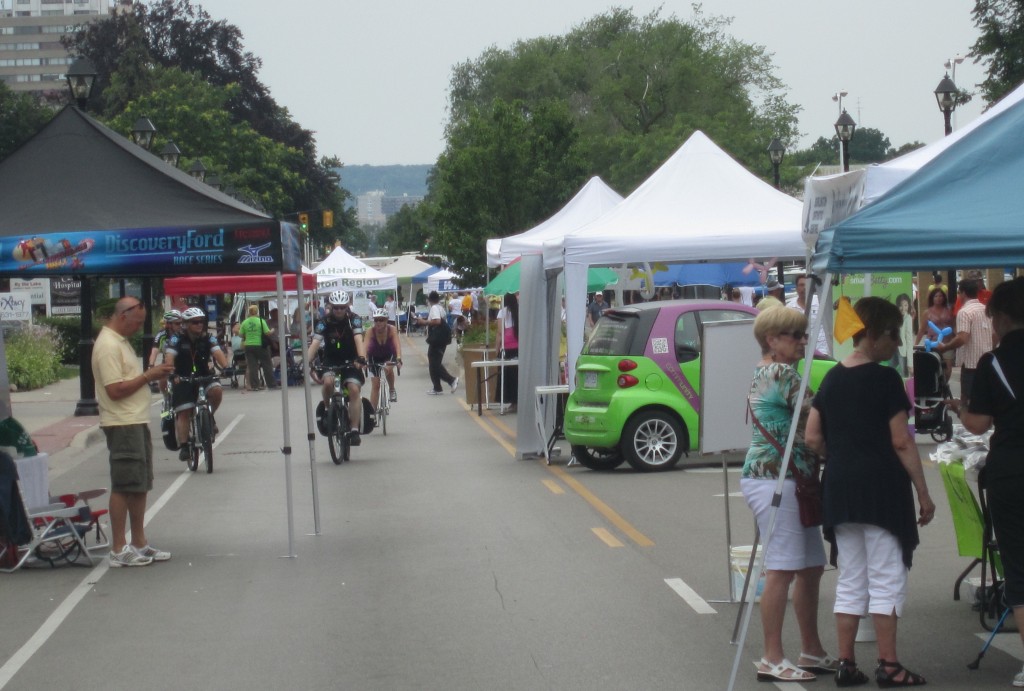 The Regional Police use bicycles on a regular basis as part of the way they do their work. Are there any other civic employees using bicycles? Burlington has gone some distance in making the city a more cycle friendly place – in this instance the city is ahead of its citizens. In June and July the city held two Car Free Sundays at which the turnout was less than expected. To the surprise of many the event on Appleby Line had a considerably better turn out than the event held on Brant Street. It was clear to many that the idea needed a re-think.
The Bicycle Friendly Communities (BFC) Program, an initiative of the Washington-based League of American Bicyclists, was launched in Canada in August 2010 by Share the Road. The program provides incentives, hands-on assistance, and award recognition for communities that actively support bicycling. Municipalities are judged in five categories often referred to as the Five “E’s” engineering, education, encouragement, enforcement, and evaluation and planning. A community must demonstrate achievements in each of the five categories in order to be considered for an award.
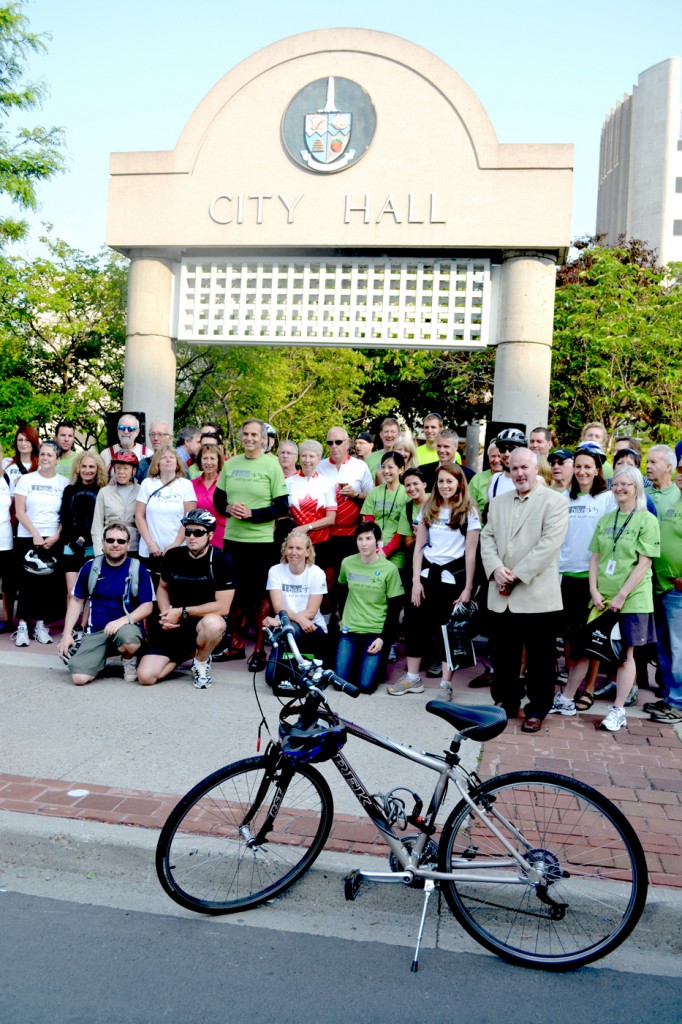 The city did a photo op in May to promote the idea of cycling to work – threw in a free breakfast for those that showed up. It wasn’t a large crowd. Councillor Dennison is the only serious and sincere cyclist on Council. Bike rack at city hall is seldom full – parking spaces at city hall are well used however – they’re free. Beats a free breakfast. “We have a lot to be proud of,” said Mayor Rick Goldring. “Over the last number of years the City of Burlington has committed to adding to our cycling-friendly infrastructure throughout the city. We have increased the number of kilometres of bike lanes and paths and made on-road cycling safer with the installation of signage, buffered and coloured lanes and sharrows. This award also recognizes the work we have done in education and awareness.”
“This award is a reflection of the hard work of city staff and our community leaders,” said Scott Stewart, general manager of development and infrastructure. “I encourage more residents to make the safe and healthy choice of cycling.”
A key focus of the city’s strategic plan, Burlington, Our Future, is increasing the number of people who cycle in the city for both recreation and transportation.
Burlington approved a Cycling Master Plan in 2009. This plan guides the city’s efforts in creating a network of on-road bikeways and multi-use pathways as well as providing policies, practices and programs to encourage more people to cycle.
Burlington has 49 km of bike lanes, 22.5 km of bike boulevards, 19 km of shared use paths and 20.7 km of multi-use paths. Bicycle racks are available at all city facilities and public art bike racks have been installed in the downtown. Bike racks are also mounted on the front of all Burlington Transit buses.
Increasing its cycling infrastructure is just part of the task: work in the areas of education and awareness continue.
The Burlington Sustainable Development Committee and Burlington Central Library are hosting an active transportation seminar; Get it in Gear, on Oct. 18th,from 7 to 9 p.m. The city has a Green Transportation Map – outlining transit routes, trails and tourism destinations in Burlington, available at the Tourism office on Brant Street.
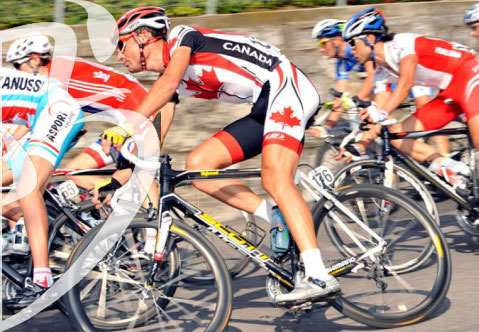 Burlington was up for a pre-Olympic cycling competition but the opportunity got away from us. Maybe in the future? Burlington got a sense of what was possible when it took a hard look at the idea of holding pre-Olympic elite level races that would have resulted in a jam packed Canada Day. That idea didn`t fly due to problems with the promoter – but we got a clear sense of what was possible. At some point the city will meet up with the right promoter and we will perhaps see elite cycle racing in the community.
In the meantime the cycling infrastructure keeps being added to and more and more roadways are truly bicycle accessible. Hopefully sooner rather than later the city will devote some time and money figuring out how to make the stretch of roadway from Mainway to Fairview bicycle friendly – that for Burlington is the real challenge at Walkers Line and Appleby Line as well. It is what creates that big divide between the Burlington north of the QEW and the Burlington south of the QEW – and until we resolve that one we won`t be united as a city. When that problem is solved – we could win gold!

 By Pepper Parr By Pepper Parr
BURLINGTON, ON August 23, 2012 When an organization brings in a new leader expect changes – that`s why the new leader was brought in.
City Manager Jeff Fielding, formerly with London, Ontario has been with Burlington for six months now and staff are getting a clearer picture of how he operates.
The city manager has traditionally used an office on the 8th floor, steps away from the Mayor. Fielding has decided to move down to the 6th floor, where he will have an office with his General Managers. Fielding wants to be where his team works and not two floors above them.
He has re-aligned some of the departments that report to the three general managers the city employs. Two, Kim Phillips and Scott Stewart are in place and a third will be hired in the fall to replace Steve Zorbas.
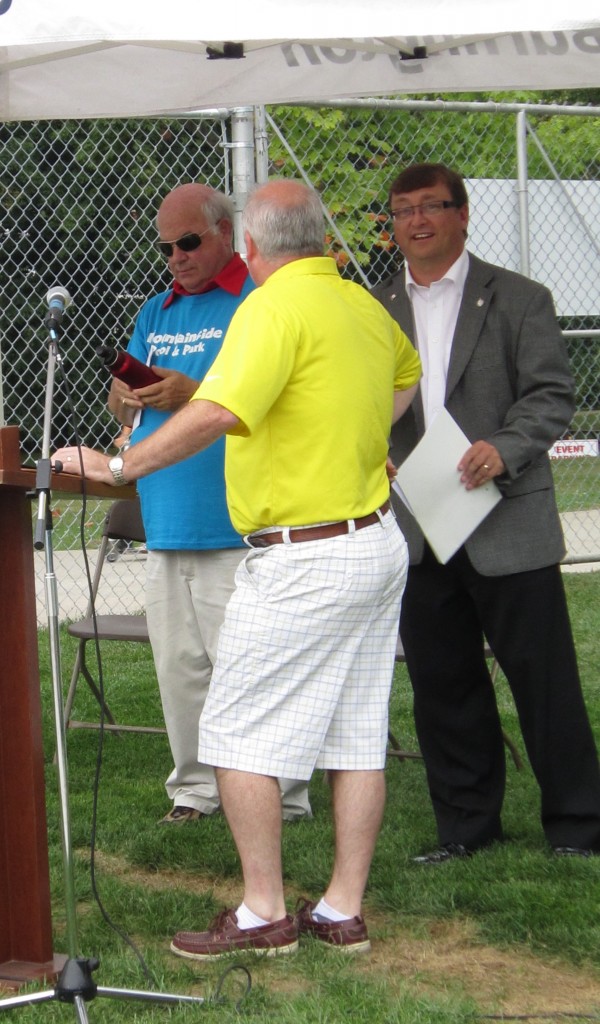 General Manager Scott Stewart wants his staff to be sharp, come up with good ideas, deliver great service and have some fun while they are at it. Here he models his vacation wear. Councillor John Taylor is on the left with MP Mike Wallace on the right General Manager Scott Stewart heads up what has been called community services – that has been renamed to General Manager Development and Infrastructure. Kim Phillips heads up what has been called Budget and Corporate Services – that will be called Corporate Services.
A third General Manager will be hired in the fourth quarter of the year and Fielding let it be known that third person could well come from within the organization. Bruce Zvaniga, who has done some excellent work recently, is serving as Acting City Manager while Stewart is on vacation. Expect Bruce to be polishing up his resume when the job is posted.
The building on Brant Street is becoming a different city hall. The budget process the city goes through this year will focus on where the city should be investing funds and not get tangled up in the weeds of how much should be spent on pencils and paper clips.
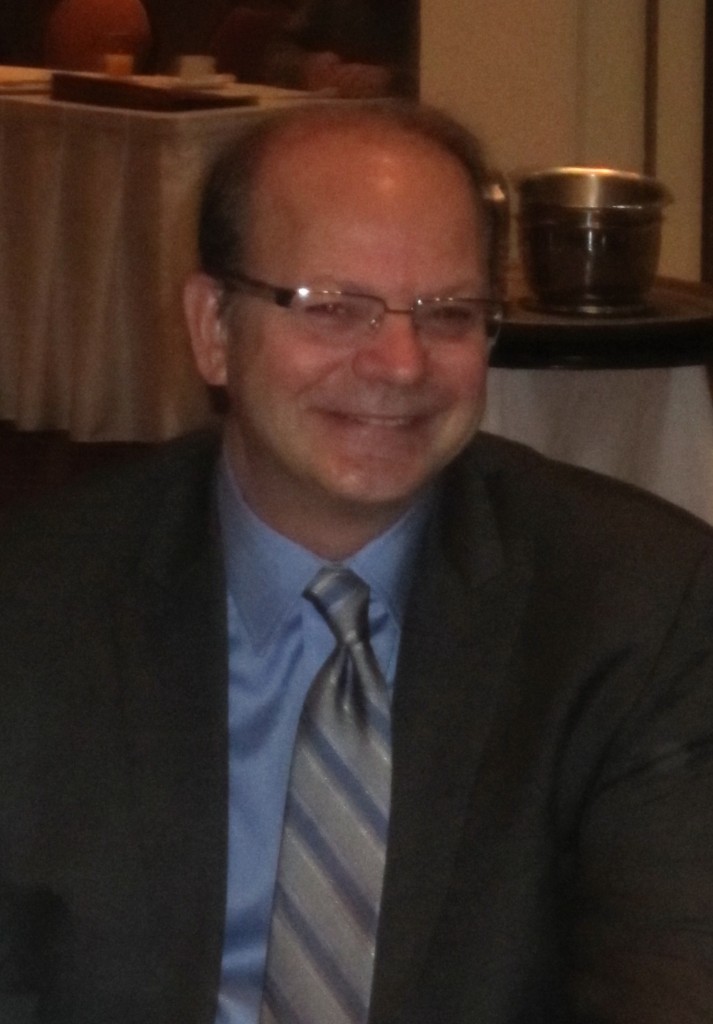 Soft spoken, direct, wants his people to be creative and bring him new ideas and then expects them to deliver on those ideas. Some staff members will not meet that challenge but for those that do, and there are lots of them, the city is going to be a great place to work. City Manager Jeff Fielding is changing the culture at city hall. In a past budget a senior staff member spent time explaining what some software would do – it was an upgrade of a program used all over the world. Fielding doesn`t want his staff spending time like this. He wants his staff to do forward thinking and will be bringing what he calls a business case approach to deciding the business the city should be in and what they shouldn’t be doing.
For Fielding it is a matter of supporting the staff in what they do, have them see themselves as collectively accountable to the public for the way the city is run. He also wants them to pick up the pace. This is certainly not the approach that was operational at city hall with the previous city manager.
For many of the sharper people at city hall it will be seen as a blessing – an opportunity for them to be both accountable and creative.
Fielding commented on a meeting he took part in earlier in the day when staff was making a presentation. The ideas they put forward “almost brought tears to my eyes”.
Economic development is going to get much more attention from city hall as is investments elsewhere in the city. Community Development Halton has been asked to prepare a business case for an approach to serving the city that will see funds invested in neighbourhoods. Joey Edwardh, Executive Director of CDH has been asked to develop a business case and bring it back to the management team where it will get discussed, debated and some recommendations developed that get taken to city council committee.
The Economic Development Corporation has been asked to produce a new business case as well. Fielding sees the EDC as an investment the city makes – and if that investment is paying off – then it should continue. Operations will continue if the business case can justify them; if not, then the question asked will be: Why are we doing this?
These business cases will be put before Council and they will decide which ones they want to fund.
Fielding tells of the 45 different services the city provides. Each is looked at, reviewed and a case for continuing with the service is put forward and Council decides which they want to continue and which should be abandoned.
For Fielding it is a matter of delivering service. Staff will be asked to make the business case and uses something as simple as the sending of an invoice. It costs the city $1 to mail an invoice but just 40 cents to send it via the web. You can see where he is going with this kind of thinking.
 Master University is developing a three year program that will significantly improve the management skills of senior and middle management staff at city hall. As many as 150 staff members will be taking courses over a three year period. Staff development is getting much more attention. The city is about to conclude an agreement with the DeGroote campus of McMaster University that will have staff taking courses designed specifically for the city. Paul Bates, Andrea Mior at McMaster and Laura Boyd and Roy Male at city hall are working this up – we may see more than thousands of children heading back to classrooms in the fall.
Fielding is asking much more of his staff than they have been used to. Those that see civic administration as a career opportunity will meet the challenge while others will begin to feel very uncomfortable at city hall. Fielding added that salaries at city hall will reflect the cost of living increases but staff won`t be getting all of it. “We are coming in a little below the actual cost of living increases.”

 By Pepper Parr By Pepper Parr
BURLINGTON, ON July 31, 2012 The Bank Investigator Scam is back. And as they usually do- they target vulnerable trusting seniors who have savings they need tucked away. Some slickster wants to take that money from you and will call saying he is an Inspector with the bank and needs your help.
Tell him you’d love to help him and then ask which branch you can meet him or her at. Then call the police.
The Halton Regional Police Service is warning seniors about a “Bank Investigator Scam”. The Canadian Anti-Fraud Centre (formerly known as Phone Busters) recently reported over 100 complaints with reported losses to victims of 1/2 million dollars.
This scam is predominantly targeting female seniors and the Canadian Anti-Fraud Centre says that the fraudsters sometimes use the obituaries to obtain personal information about their potential victims.
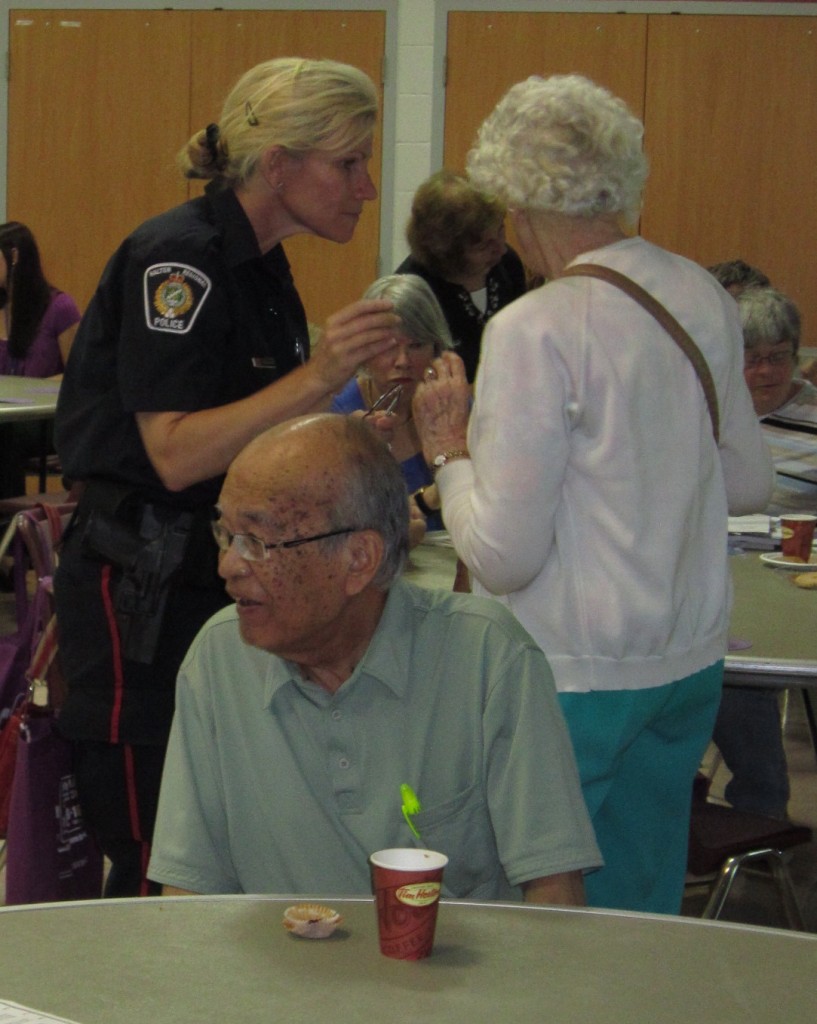 Constable Wendy Moraghan works with seniors in the Region as the Elder Services Coordinator. If you think there is something fishy about a phone call you get – call Wendy, she’s there to help. The fraudsters contact seniors by phone advising that they require their assistance to catch a bank employee that “has been stealing money”. The person is instructed to go to their bank and make a cash withdrawal, usually in 100 dollar bills, for amounts in the $5000.00 range. The person is told not to tell the bank teller what they are doing because the teller may be involved.
 When anyone asks you to to withdraw cash from your bank account and meet them in a parking lot – let them know you would prefer to meet in the parking lot of the police station and hang up. The senior is instructed to place the cash in an envelope and meet the “investigator” in a nearby parking lot where the cash is turned over. If successful the “investigator” attempts a further request for funds to ensure the investigation is a success. On one occasion the “investigator” also asked if the senior had any cash at home because the employee had been handing out counterfeit money.
The senior turned over $6,000.00 in cash from her residence which the “investigator” confirmed was counterfeit by looking at the serial numbers. The fraudsters will represent various different financial institutions. The public is reminded that this is not the way banks operate. If there is an investigation it is done by the police.
Police constable Wendy Moraghan (Elder Services Coordinator) with the Halton Regional Police Service is as far away as a telephone call – if you’re suspicious – give her a call -905-825-4777 ext. 5064 She’s a real sweetheart and will answer every question you have – she’s there to help you.
Moraghan will tell you to never give out personal information on the telephone to anyone. Constable Moraghan attends many seniors events in the Region.

 By Staff By Staff
BURLINGTON, ON June 21, 2012 Halton Regional Police Service is investigating a break and enter at St. Christopher Elementary School located on 2400 Sutton Drive. It is unknown how the suspect(s) entered the school, but it is possible a door was accidentally left unlocked.
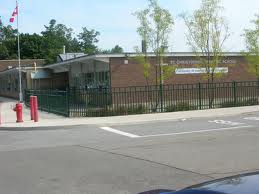 Classroom flooded - floor damaged when tap turned on in a sink with plug in place Suspects entered one classroom, put a plug in the sink and turned the water on, causing the sink to overflow. The result was water damage to the surrounding counter, as well as books, and other school materials and supplies. Damage is estimated at $500 – $1000.

 By Pepper Parr By Pepper Parr
BURLINGTON, ON June 10, 2012 He launched and managed to gain some altitude and it looks like he will stay aloft.
Jeremy Freiburger told a close to full house in the Performing Arts Community Studio the fundamentals of the community engagement part of the Cultural Plan that he has been contracted to prepare for the city of Burlington.
Freiburger is well qualified to take on the task and brings both energy and innovation to the work he has to do.
He does have his hands full working with the city’s communications people – but then he’s not the only one struggling with that department.
Freiburger has arranged to meet with citizens in every ward and while the turnout has not been large – those that did show up were enthusiastic. The first event was in Kilbride – to the surprise of many – culture is usually seen as something that happens south of the 401.
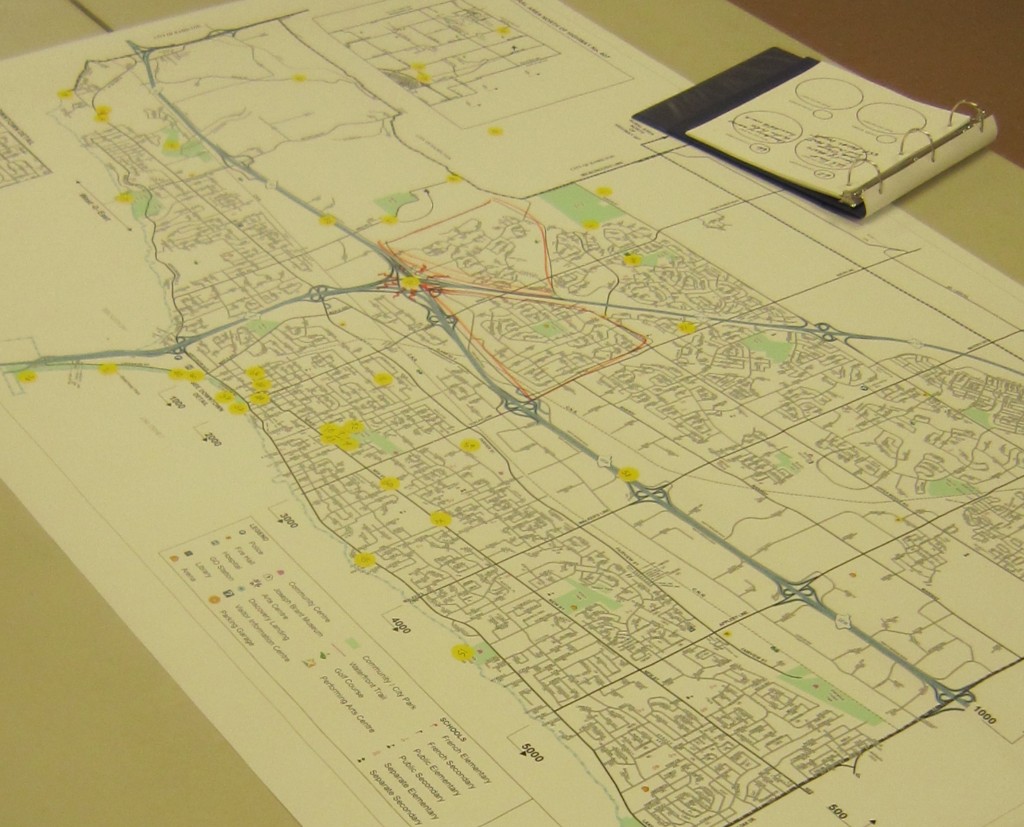 Each yellow marker indicates a location that someone saw as culturally significant. The turnout was better in Kilbride than it was at the Senior’s Centre which is smack dab in the middle of Ward 2 where all the cultural mavens are thought to live. So much for that thought.
While Freiburger was talking to the audience in Kilbride about what he is setting out to do – a group playing baseball got rained out; Freiburger didn’t miss a beat – he invited them in to hear what they had to say about culture. This guy clearly knows how to innovate.
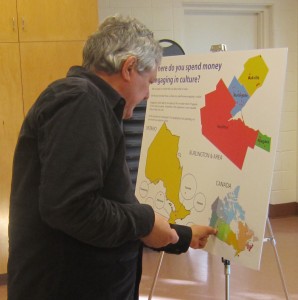 David Auger thinks about where he spends his disposable income dollars on culture. Freiburger asks those who show up to do three things for him. Put a small dot on a map showing where they spend their cultural time and then go to an identical map and put down dots showing where you spend their cultural money.
Then Freiburger asks people to go to a very large map of the city and put down stickers on the places they like to go in the city. Lowville Park, put a sticker there, Student Theatre, put another sticker there. Freiburger wants to map points of cultural significance.
Out of all this data collection will come a picture of where people spend their time, where they spend their money and what it is about places they go to that attracts them.
Freiburger will be collecting data at events in each ward, for almost the first time we have seen events take place well north of the QEW divide. It would have been nice to see something in the Alton and Orchard communities. The Sound of Music crowd will be invited to take part in this exercise. If you didn’t get to one of the community events – Sound of Music and the Children’s Festival are good opportunities to take part in the data gathering
The crowd at the Performing Arts Centre heard Edie Friel, the man who put the city of Glasgow on the cultural map and made cultural events the strongest part of the Glaswegian economy by using a model from Azerbaijan to catch people’s attention. Using an Azerbaijani model to get the attention of people in Glasgow – – that’s chutzpah!
Friel explained the role culture plays in the development of a city. “People”, he said “don’t go to France, they go to Paris. People don’t go to Italy; they go to Milan or Rome. People go to cities because those cities have created a brand for themselves, a reason to go to that city.”
“When you brand a city you highlight it’s history, its heritage and its culture”, he said. We will come back to those three – they are very relevant to Burlington.
Friel pointed out that “we human beings have a need for membership, we want to belong to something”. That something can be a model railroad club, a photography club, a drama group. People go to things they identify with. There are literally thousands of people in Ontario who want to do nothing more than walk the Bruce Trail.
Most people either know what they want to do with their time and their disposable income or know they are open to a new idea; a new experience. Friel talks of “destination marketing” and he explains that you have to develop the “supply chain”. What does all that mean?
If Burlington is going to attract visitors we have to give them a reason for coming to the city – and those reasons are what he refers to as the supply chain. “Develop the brand” says Friel – “not the artists. When you do that, then people will come and see all the artists.”
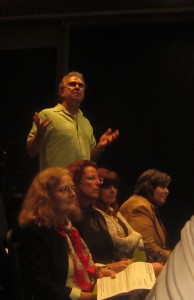 This artists wants to be a little higher up on the food chain - wants people to pay for the work artists do. There was at least one artist in the audience who didn’t see it quite that way. While he had no problem being part of the supply chain he suggested that the artists could be a little higher up on that chain and complained about artists being asked to do their work for free by people who had good jobs running the cultural institutions in the city.
A near perfect example of just that happening is the two events held at the Burlington Art Centre on the weekend. The BAC had invited more than 100 artists to show their work and at the same time has the six Guilds that work out of the BAC showing their work. The crowds will not be coming to see a specific artist – they will be here looking at artisans and while here get a good look at what the BAC does day to day.
Just what is the Burlington brand? Is Freiburger expected to create a brand for the city? Nope – his job is to put together a plan to market Burlington and its culture – without really knowing what that culture is. THAT is a task and a half. Burlington is certainly festivals. Is it a gathering place for artists? Maybe not yet – but if the Burlington brand is fully developed and exploited the city will become known as the place that always has a festival of some kind going on. If you develop the brand, if you make Burlington a place where people know there are a lot of artists – they will come.
Niagara on the Lake has a very clear brand? Well yes and no. The Shaw Festival takes place there but the Shaw is not the Niagara on the Lake brand. Stratford on the other hand is Shakespeare.
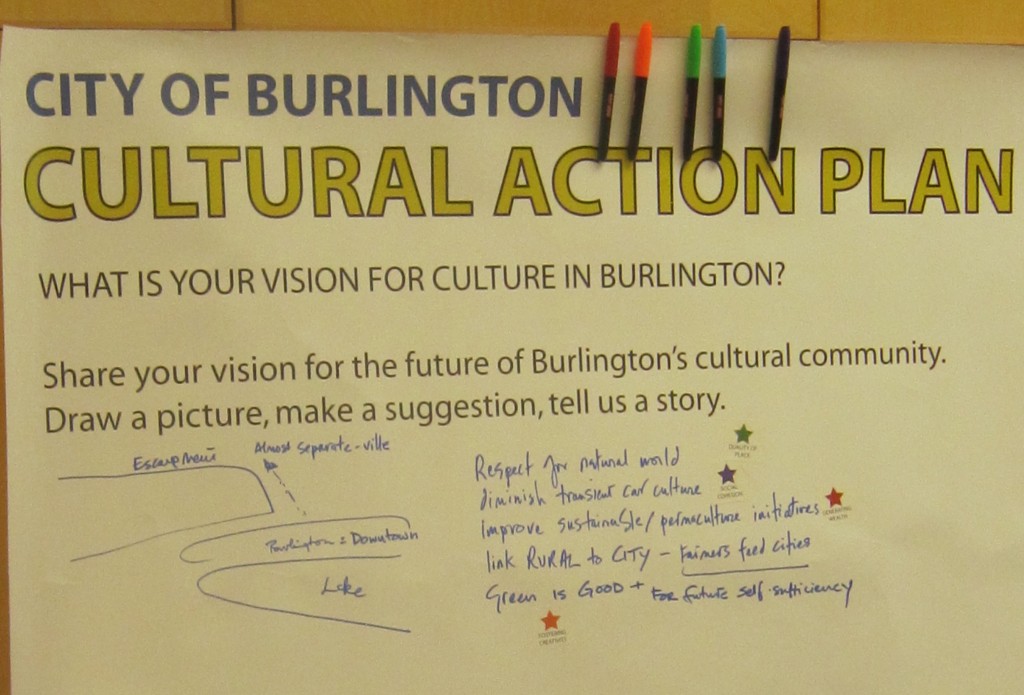 Besides mapping data participants in the Cultural Conversations were asked to contribute their thoughts and ideas. The city has several events that are part of the brand – the Sound of Music Festival and RibFest – both of which need significant image upgrades. That’s not a criticism – it’s an observation. Burlington types are very edgy when it comes to making any kind of observation about how they are doing. The drama people understand the significant role criticism plays. Good critical comment helps an actor or actress improve their importance.
“A community” advised Friel, “has to believe in itself. You have to decide what the place is going to look like.” Now back to his comment about a community and its history, its heritage and its culture.
Burlington struggles with its history. There is a plaque in the western end of Spencer Smith Park that tells you the Brant Inn once stood there – but it doesn’t tell you very much about the Brant Inn and the very significant cultural events that took place there.
The Burlington Heritage Advisory committee is struggling with a way to get the community to agree on some format to recognize those structures in the city that are of cultural significance. That problem is almost like a festering wound with two sides not seeing the issue the same way.
The Freeman railway station has had to fight and scratch its way to stay alive despite a city council that exhibited truly disgraceful behaviour. Were it not for the efforts of Councillors Meed Ward and Lancaster the structure would be fire place kindling somewhere. It isn’t a completely done deal yet but there is every reason to believe that the structure will be saved and that at some time in the future – maybe before the pier is officially opened – Freeman Station will be open for the public to use.
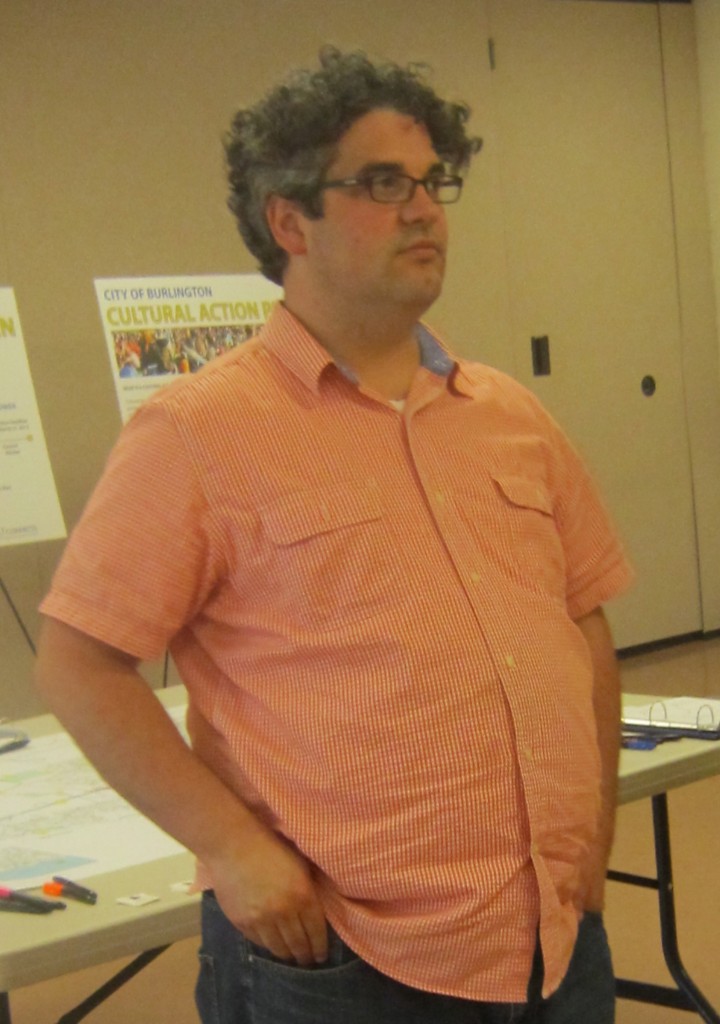 Jeremy Freiburger - leading a committee with a mandate to come up with a Cultural Plan for the city. The question that comes out of all this is – how does a city create a cultural plan if it doesn’t have a clear firm sense of what its history is or a civic administration that strives to support and maintain that history? There was a point when Burlington had hundreds of thousands of dollars to restore and find a home for the structure – but the city couldn’t get agreement on where it should be located and the federal/provincial and municipal funding that was in place to do this was lost – it got used to pave some streets instead.
Burlington was once one of the premier locations in the province for fruit farms – that land got turned into shopping malls. Burlington and Maple View malls were once orchards – now they are covered in asphalt and serve as parking lots. The Freeman Station was one of several stations where barrels of apples were loaded into freight trains. There was once a cannery operation at the edge of the lake. Not even a plaque there now to mark a very important part of the city’s history.
Jeremy Freiburger has his work cut out for him. The city is at least looking at how culture can be highlighted and the city turned into a tourist destination. The basic elements are there – all we have to do is bring them to the surface, polish them up and Burlington will be a place to visit and spend some money while they are here.
Is that what this is all about?
We will follow the development of this plan.

 By Pepper Parr By Pepper Parr
BURLINGTON, ON May 28, 2012 TEDx Burlington came and went – some 100 people plus filled the Community Room of the Performing Arts Centre and then trooped up Locust Street to ThinkSpot! after the three hour event, where they munched on sandwiches and continued the conversation. In a couple of weeks the Burlington ideas worth talking about will be up on the TED web site and those of you who couldn’t score a ticket will be able to see what the rest of us took in. We will let you know when the presentations are available for the rest of the public.
Some very powerful statements were made. There was some difficulty managing the time allotted to each speaker – they were supposed to be limited to 18 minutes and that didn’t work with the one session, to the point where the impact of the point the speaker was making was lost.
The live presentations were interspersed with feeds from some of the really great presentations done in the past by other TEDx’s
TEDx is about ideas that are worth talking about and the story Arthur Fleischmann told of his daughter Carly was amazing – but was it an idea worth talking about? It wasn’t an idea – it was the story of a man and his autistic daughter who has made tremendous strides and as a teenager has come to the point where she can communicate with people like us. The story is truly magnificent and we will pass it along to you when they have been prepared for internet loading – it wasn’t an idea that revealed anything to me other than the courage her Father has shown as he walked with his child.
The Josh Nelson story was told – Josh wasn’t able to make it to the live session. Dramatic, tearful, the story of immense personal courage. But was it an idea worth talking about?
Scott Graham told about bullying and the damage done. He mentioned more than half a dozen students who had committed suicide. – the two woman beside me could not hold back the tears. It was very hard to listen to and they didn’t return after the break.
TED was a concept developed to take ideas that people had; ideas worth talking about and give them a public forum. Two of the ideas that came out of past TED sessions held in other cities are set out for you below.
Both are quite short – one is a great idea about how we can solve a serious problem with getting clean water that people can drink during a crisis when water is available only in plastic bottles. This is something that is really worth talking about. The Mayor was in the room – will he order a dozen or so and have the Emergency Measures Service people try them out? He should.
Derek Sivers told of the way we identify where we live with street addresses and the way the people of Japan describe where they live. It is certainly very different and as you listen to the explanation you realize that it wouldn’t work here but it works there – why? An idea worth talking about? Yes most certainly.
Of the seven presentations seen Sunday afternoon in an event that was about an hour too long, were any likely to make it onto that list of presentations that will be watched again and again by people around the world? Other than the comments Patrick O`Neil made about how we in North America tend to use our heads and brains instead of our hearts and maybe the comments Deb Pickfield made about complacency – but other than that – probably not.
One needs to be fair. Spencer Campbell deserves buckets of credit for taking the initiative to bring TED to Burlington and then doing all the calling around and setting up that makes events like this work. It was announced at the first annual TEDxBurlington event – which would suggest there will be another TEDx held in Burlington. Only time will tell if that proves to be the case. Should there be another
An interesting observation. Four times a year the Mayor of Burlington sponsors a speaker – all the seats available are usually filled for hour and a quarter presentation made by very informed, qualified speakers – several with national and international reputations. The crowd that usually attends the Mayor’s Inspire speakers event was not the same crowd that was in the Community Room this afternoon, which suggests there is a larger audience than we have seen in the past for quality events that engage the mind. For that reason alone Spencer Campbell should begin now to prepare for the next session of TEDxBurlington. Is there a personal Spencer Campbell agenda here? Isn’t there always?

 By Pepper Parr By Pepper Parr
BURLINGTON, ON April 21, 2012 It was her first book reading. She was in Burlington at the Different Drummer to celebrate the launch of her first novel; Rachel’s Secret. The small room at the Drummer was packed with at least a third of the audience made up of people who knew the author but that didn’t deter them from buying books. Many, many people bought three and four copies of Rachel’s Secret by Shelley Sanders.
 Shelley Sanders wait for a book buyer to say what she wants the inscription inside Rachel's Secret to say. Sanders began her presentation with a short visual presentation about the background of the time period the book was written about which made the point she wanted to make. She then stood there looking at her audience and they sat and looked back – this went on for a few minutes and then Sanders moved abruptly and said: Oh, I`m supposed to read from my book now” and began her reading which went just fine.
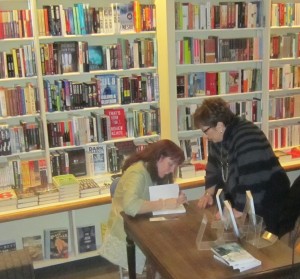 New Canadian author Shelley Sanders signs books at Different Drummer launch. Missing her cue made the occasion just that much more real and pleasurable. The book will sell well enough and one should expect to see a second title from this author.
The event had a nice home spun feel to it. The refreshments were made by the author and she explained in some detail what was in each, and one expected her to say that she would pass along the recipe if you wanted it.
Set in pre-revolutionary Russia, where tensions are high between the Jewish and Christian populations. Rachel, who is a Jew, and Sergei, a Christian, find their worlds torn apart by violence as lies about Jews leap off the pages of the local newspaper. Vicious riots break out on Easter Sunday, 1903, and when they finally end, almost three days later, Rachel finds that the person she loves most is dead and that her home has been destroyed. As she struggles to survive the aftermath of the riots—or pogroms—support comes from someone totally unexpected, as Sergei turns against his father to help Rachel. With everything against them, the two young people don’t want to fight the bond that is growing between them, one of the few signs of goodness and hope in a time of chaos and violence.
The basics of the story are factual; there is some novelization needed to ensure this wasn’t just a history book. The editor of the newspaper in the town of Kishinev continually published brutally damaging headlines that built the tension in the community around the murder of a young man is a true and terrible example of the lies that drove much of the anti-Semitic literature that was behind the Nazi ideology. On that level alone the book is a good example for young readers of what vicious propaganda can do to a society.
 It was THE best selling book at the Different Drummer Saturday afternoon when Shelley Sanders launched the book. The grandmother, the story is built around, was Shelley Sanders’ grandmother which is what inspired the author. Her grandmother`s horrific experience may have been what more than 100 years later launched a new Canadian writer.
Ian Elliot, proprietor of A Different Drummer is using the launch of Rachel`s Secret at his book store as the first step in the creation of a Teen Book Club.
The Kirkus review, a literary publication librarians rely upon for reviews of new titles had this to say about the title: “Sanders’ debut has generic prose and occasional anachronisms, but nonetheless adeptly conveys the history, from Mikhail Rybachenko’s real name to the bitter bigotry and bloodbath”, which is not bad for the first effort by a new Canadian novelist.

|
|
 The three parts are 35 Live, 35 Onsite and 35 Online auctions for objects from visual artists working in all medium. Entries for the three auctions will be selected by a jury of experts to ensure quality and an offering of unique and original pieces.
The three parts are 35 Live, 35 Onsite and 35 Online auctions for objects from visual artists working in all medium. Entries for the three auctions will be selected by a jury of experts to ensure quality and an offering of unique and original pieces.




































































































